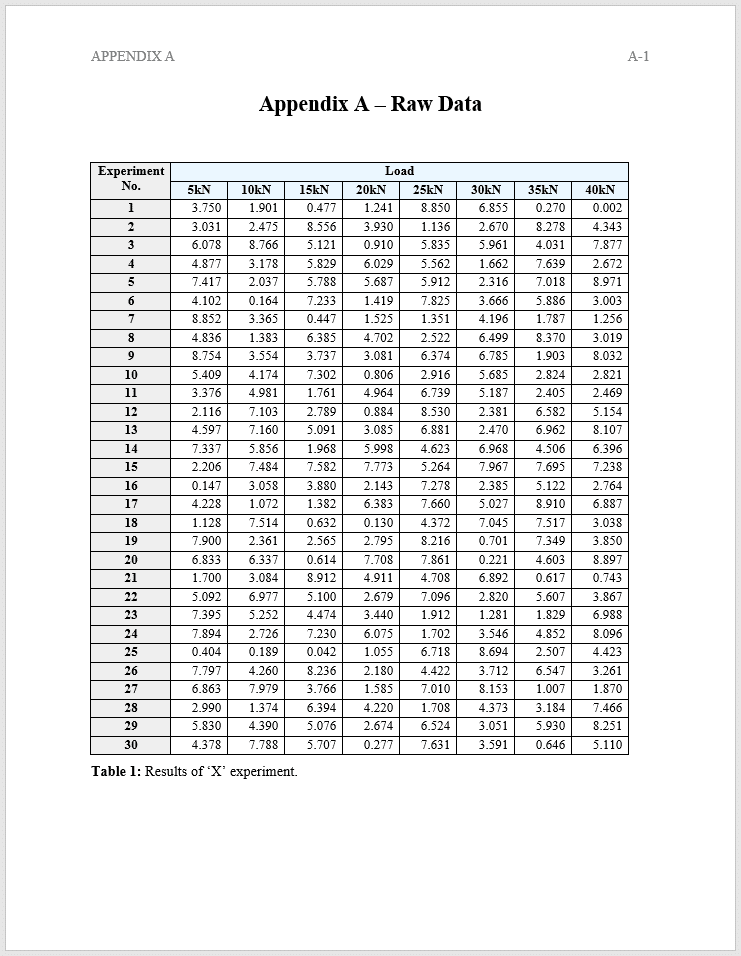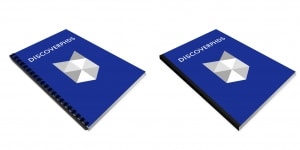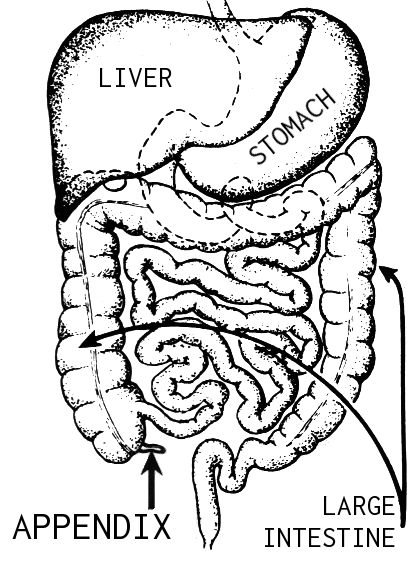

Community Blog
Keep up-to-date on postgraduate related issues with our quick reads written by students, postdocs, professors and industry leaders.
Thesis and Dissertation Appendicies – What to Include
- By DiscoverPhDs
- August 12, 2020

An appendix is a section at the end of a dissertation that contains supplementary information. An appendix may contain figures, tables, raw data, and other additional information that supports the arguments of your dissertation but do not belong in the main body.
It can be either a long appendix or split into several smaller appendices. Each appendix should have its own title and identification letters, and the numbering for any tables or figures in them should be reset at the beginning of each new appendix.
Purpose of an Appendix
When writing the main body of your dissertation, it is important to keep it short and concise in order to convey your arguments effectively.
Given the amount of research you would have done, you will probably have a lot of additional information that you would like to share with your audience.
This is where appendices come in. Any information that doesn’t support your main arguments or isn’t directly relevant to the topic of your dissertation should be placed in an appendix.
This will help you organise your paper, as only information that adds weight to your arguments will be included; it will also help improve your flow by minimising unnecessary interruptions.
Note, however, that your main body must be detailed enough that it can be understood without your appendices. If a reader has to flip between pages to make sense of what they are reading, they are unlikely to understand it.
For this reason, appendices should only be used for supporting background material and not for any content that doesn’t fit into your word count, such as the second half of your literature review .
What to Include in a Dissertation Appendix
A dissertation appendix can be used for the following supplementary information:
Research Results
There are various ways in which research results can be presented, such as in tables or diagrams.
Although all of your results will be useful to some extent, you won’t be able to include them all in the main body of your dissertation. Consequently, only those that are crucial to answering your research question should be included.
Your other less significant findings should be placed in your appendix, including raw data, proof of control measures, and other supplemental material.
Details of Questionnaires and Interviews
You can choose to include the details of any surveys and interviews you have conducted. This can include:
- An interview transcript,
- A copy of any survey questions,
- Questionnaire results.
Although the results of your surveys, questionnaires or interviews should be presented and discussed in your main text, it is useful to include their full form in the appendix of a dissertation to give credibility to your study.
Tables, Figures and Illustrations
If your dissertation contains a large number of tables, figures and illustrative material, it may be helpful to insert the less important ones in your appendix. For example, if you have four related datasets, you could present all the data and trend lines (made identifiable by different colours) on a single chart with a further breakdown for each dataset in your appendix.
Letters and Correspondence
If you have letters or correspondence, either between yourself and other researchers or places where you sought permission to reuse copyrighted material, they should be included here. This will help ensure that your dissertation doesn’t become suspected of plagiarism.
List of Abbreviations
Most researchers will provide a list of abbreviations at the beginning of their dissertation, but if not, it would be wise to add them as an appendix.
This is because not all of your readers will have the same background as you and therefore may have difficulty understanding the abbreviations and technical terms you use.
Note: Some researchers refer to this as a ‘glossary’, especially if it is provided as an appendix section. For all intended purposes, this is the same as a list of abbreviations.
Finding a PhD has never been this easy – search for a PhD by keyword, location or academic area of interest.
How to Format a Dissertation Appendix
In regards to format, you can include one lengthy appendix or structure it into several smaller appendices.
Although the choice is yours, it is usually better to opt for several different appendices as it allows you to organise your supplementary information into different categories based on what they are.
The following guidelines should be observed when preparing your dissertation appendices section:
- Each appendix should start on a new page and be given a unique title and identifying letter, such as “Appendix A – Raw Data”. This allows you to more easily refer to appendix headings in the text of your main body should you need to.
- Each appendix should have its own page numbering system, comprising the appendix identification letter and the corresponding page number. The appendix identification letter should be reset for each appendix, but the page number should remain continuous. For example, if ‘Appendix A’ has three pages and ‘Appendix B’ two pages, the page numbers should be A-1, A-2, A-3, B-4, B-5.
- The numbering of tables and figures should be reset at the beginning of each new appendix. For example, if ‘Appendix A’ contains two tables and ‘Appendix B’ one table, the table number within Appendix B should be ‘Table 1’ and not ‘Table 3’.
- If you have multiple appendices instead of a single longer one, insert a ‘List of Appendices’ in the same way as your contents page.
- Use the same formatting (font size, font type, spacing, margins, etc.) as the rest of your report.
Example of Appendices
Below is an example of what a thesis or dissertation appendix could look like.

Referring to an Appendix In-Text
You must refer to each appendix in the main body of your dissertation at least once to justify its inclusion; otherwise, the question arises as to whether they are really needed.
You can refer to an appendix in one of three ways:
1. Refer to a specific figure or table within a sentence, for example: “As shown in Table 2 of Appendix A, there is little correlation between X and Y”.
2. Refer to a specific figure or table in parentheses, for example: “The results (refer to Table 2 of Appendix A) show that there is little correlation between X and Y”.
3. Refer to an entire appendix, for example: “The output data can be found in Appendix A”.
Appendices vs Appendixes
Both terms are correct, so it is up to you which one you prefer. However, it is worth noting that ‘appendices’ are used more frequently in the science and research community, so we recommend using the former in academic writing if you have no preferences.
Where Does an Appendix Go?
For a dissertation, your appendices should be inserted after your reference list.
Some people like to put their appendices in a standalone document to separate it from the rest of their report, but we only recommend this at the request of your dissertation supervisor, as this isn’t common practice.
Note : Your university may have its own requirements or formatting suggestions for writing your dissertation or thesis appendix. As such, make sure you check with your supervisor or department before you work on your appendices. This will especially be the case for any students working on a thesis.

Find out the different dissertation and thesis binding options, which is best, advantages and disadvantages, typical costs, popular services and more.

Reference management software solutions offer a powerful way for you to track and manage your academic references. Read our blog post to learn more about what they are and how to use them.

Academic conferences are expensive and it can be tough finding the funds to go; this naturally leads to the question of are academic conferences worth it?
Join thousands of other students and stay up to date with the latest PhD programmes, funding opportunities and advice.

Browse PhDs Now

Impostor Syndrome is a common phenomenon amongst PhD students, leading to self-doubt and fear of being exposed as a “fraud”. How can we overcome these feelings?

Choosing a good PhD supervisor will be paramount to your success as a PhD student, but what qualities should you be looking for? Read our post to find out.

Dr Ayres completed her PhD at the University of Warwick in 2017, researching the use of diamond to make electrochemical sensors. She is now a research scientists in the water industry, developing different analytical techniques and sensors to help keep our water systems safe.

Jay is in the third year of his PhD at Savitribai Phule Pune University, researching the applications of mesenchymal stem cells and nanocarrier for bone tissue engineering.
Join Thousands of Students

- Langson Library
- Science Library
- Grunigen Medical Library
- Law Library
- Connect From Off-Campus
- Accessibility
- Gateway Study Center

Email this link
Thesis / dissertation formatting manual (2024).
- Filing Fees and Student Status
- Submission Process Overview
- Electronic Thesis Submission
- Paper Thesis Submission
- Formatting Overview
- Fonts/Typeface
- Pagination, Margins, Spacing
- Paper Thesis Formatting
- Preliminary Pages Overview
- Copyright Page
- Dedication Page
- Table of Contents
- List of Figures (etc.)
- Acknowledgements
- Text and References Overview
- Figures and Illustrations
- Using Your Own Previously Published Materials
- Using Copyrighted Materials by Another Author
- Open Access and Embargoes
- Copyright and Creative Commons
- Ordering Print (Bound) Copies
- Tutorials and Assistance
- FAQ This link opens in a new window
Appendices within Manuscript
Appendices may be included as part of the manuscript. These typically appear after the Bibliography or References section.
- List the Appendices in the Table of Contents
- Do not restart page numbering for your Appendices. For example, if the last page of your Bibliography is 195, your first Appendix page number should be 196.
Appendices as Supplemental Files
Electronic or audiovisual data may be included as Supplemental Files in an ETD submission. Your committee should agree that the information contained in the supplemental files is of such a character that a medium other than text is necessary.
When uploading your manuscript to ProQuest, there is a place to upload Supplemental Files separate from the main PDF upload (see screen capture below).

- << Previous: Figures and Illustrations
- Next: IV. Using Previously Published Material >>
- Last Updated: May 31, 2024 9:34 AM
- URL: https://guides.lib.uci.edu/gradmanual
Off-campus? Please use the Software VPN and choose the group UCIFull to access licensed content. For more information, please Click here
Software VPN is not available for guests, so they may not have access to some content when connecting from off-campus.

Graduate College Formatting Guide
- Page Numbers (Microsoft Word)
- Page Numbers (Google Docs)
- Page Breaks and Section Breaks
- Headings, Subheadings, and Table of Contents (Microsoft Word)
- Headings, Subheadings, and Table of Contents (Google Docs)
- Inserting Tables and Figures
- Comments and Track Changes
- References, Bibliography, Works Cited
- Landscape Pages & Special Materials
Using Appendices
Some theses/dissertations need space for extra materials relevant to the work but not appropriate in the main body of text, such as IRB approvals. For these, appendices are useful.* Appendices should go after your references/works cited list, should be formatted as Heading 1, and as such should appear in your Table of Contents. Any Tables or Figures that appear in an appendix should also appear in its respective list. Finally, when referring to an appendix within the body of the work, please refer to them as "Appendix A," "Appendix B," etc.
*Note: the following example screenshots will have the "Show/hide formatting marks" option toggled on. To see how to enable/disable this feature, see Landscape Pages & Special Materials.
To add an appendix, first create a new page after your references list (to do so, see Page Breaks and Section Breaks). Type Appendix A at the top and set it to Heading 1.

Most students prefer to title their appendices, though this step is optional.

You can repeat this process as many times as necessary to include all of your extra materials.
Updating the Table of Contents for Appendices
If you've already inserted a Table of Contents in your document, appendices won't appear immediately in this table once they're added. To show your changes, right click anywhere inside of your Table of Contents and click Update Field

You might receive a pop-up asking if you want to update the entire table or just the page numbers. Select Update entire table.

Any added appendices should now appear in your Table of Contents.

- << Previous: References, Bibliography, Works Cited
- Next: Landscape Pages & Special Materials >>
- Last Updated: Apr 19, 2024 2:45 PM
- URL: https://guides.lib.uni.edu/grad-college-format
- Deutschland
- United Kingdom

- PhD Dissertations
- Master’s Dissertations
- Bachelor’s Dissertations
- Scientific Dissertations
- Medical Dissertations
- Bioscience Dissertations
- Social Sciences Dissertations
- Psychology Dissertations
- Humanities Dissertations
- Engineering Dissertations
- Economics Dissertations
- Service Overview
- Revisión en inglés
- Relecture en anglais
- Revisão em inglês
Manuscript Editing
- Research Paper Editing
- Lektorat Doktorarbeit
- Dissertation Proofreading
- Englisches Lektorat
- Journal Manuscript Editing
- Scientific Manuscript Editing Services
- Book Manuscript Editing
- PhD Thesis Proofreading Services
- Wissenschaftslektorat
- Korektura anglického textu
- Akademisches Lektorat
- Journal Article Editing
- Manuscript Editing Services
PhD Thesis Editing
- Medical Editing Sciences
- Proofreading Rates UK
- Medical Proofreading
- PhD Proofreading
- Academic Proofreading
- PhD Proofreaders
- Best Dissertation Proofreaders
- Masters Dissertation Proofreading
- Proofreading PhD Thesis Price
- PhD Dissertation Editing
- Lektorat Englisch Preise
- Lektorieren Englisch
- Wissenschaftliches Lektorat
- Thesis Proofreading Services
- PhD Thesis Proofreading
- Proofreading Thesis Cost
- Proofreading Thesis
- Thesis Editing Services
- Professional Thesis Editing
- PhD Thesis Editing Services
- Thesis Editing Cost
- Dissertation Proofreading Services
- Proofreading Dissertation
PhD Dissertation Proofreading
- Dissertation Proofreading Cost
- Dissertation Proofreader
- Correção de Artigos Científicos
- Correção de Trabalhos Academicos
- Serviços de Correção de Inglês
- Correção de Dissertação
- Correção de Textos Precos
- Revision en Ingles
- Revision de Textos en Ingles
- Revision de Tesis
- Revision Medica en Ingles
- Revision de Tesis Precio
- Revisão de Artigos Científicos
- Revisão de Trabalhos Academicos
- Serviços de Revisão de Inglês
- Revisão de Dissertação
- Revisão de Textos Precos
- Corrección de Textos en Ingles
- Corrección de Tesis
- Corrección de Tesis Precio
- Corrección Medica en Ingles
- Corrector ingles
- Choosing the right Journal
- Journal Editor’s Feedback
- Dealing with Rejection
- Quantitative Research Examples
- Number of scientific papers published per year
- Acknowledgements Example
- ISO, ANSI, CFR & Other
- Types of Peer Review
- Withdrawing a Paper
- What is a good h-index
- Appendix paper
- Cover Letter Templates
- Writing an Article
- How To Write the Findings
- Abbreviations: ‘Ibid.’ & ‘Id.’
- Sample letter to editor for publication
- Tables and figures in research paper
- Journal Metrics
- Revision Process of Journal Publishing
- JOURNAL GUIDELINES
Select Page
Appendices, References, Acknowledgements and Other Final Things
Posted by Rene Tetzner | Oct 22, 2021 | PhD Success | 0 |

4.6 Appendices, References, Acknowledgements and Other Final Things
4.6.1 Appendices
As I mentioned in Sections 1.4.1 and 3.5.3, appendices are not required in a thesis, but they are often included. If you are considering appendices for your thesis, check your university or department guidelines or discuss the idea with your supervisor to be certain that they will be received positively. It is also a good idea to revisit at this point any length or word count requirements or limitations set for doctoral theses by your university or department, because if you have already reached the upper limit, including appendices may require cutting other material, and in such situations appendices should only be considered if they are absolutely necessary. However, appendices are often preferable to extensive or overly long footnotes or endnotes or too much supplementary information in the main text of a thesis, both of which can distract readers from your main argument. For this reason, an effective strategy may be to move such material from the main text or notes into an appendix, since this sort of revision will not significantly alter the overall length or word count of your thesis. If, on the other hand, your thesis is a little shy of the minimum length requirement, you may want to add an appendix or two for supplementary information that you originally cut out of the thesis, but that could usefully be included: this can help you increase the word count to meet requirements. Your decision regarding the inclusion of appendices may also be simplified by the following information and advice.
As a general rule, appendices present subsidiary or supplementary material that is directly related to the material in the thesis itself and potentially helpful to readers, but which might prove distracting or inappropriate or simply too long were it included in the main body of the thesis or in notes (long footnotes in particular can make the layout of pages unattractive and should be avoided). An appendix is also a good format for material that is mentioned or discussed in more than one chapter, part or section of a thesis, because it helps the author avoid repetition while rendering the information readily available to readers. Appendices can contain a wide variety of material, such as texts discussed in the thesis, translations, chronologies, genealogies, examples of principles and procedures, descriptions of complex pieces of equipment, survey questionnaires, participant responses, detailed demographics for a population or sample, lists (particularly long ones), tables and figures, explanations or elaborations of any aspect of a study and any other supplementary information relevant to a thesis.

This material should not be included in an appendix simply because it is interesting and you happen to have it, however; instead, appendices should be included ‘only if they help readers to understand, evaluate, or replicate the study or theoretical argument being made’ ( Publication Manual of the APA , 2010, p.40). An appendix ‘should not be a repository for odds and ends that the author could not work into the text’ ( Chicago Manual of Style , 2003, p.27). Ideally, each appendix should have a specific theme, focus or function and gather materials of a particular type or relating to a particular topic, and it should bear a main heading that describes its content (e.g., ‘Appendix: Questionnaire 3 in Spanish and English’). If more than one theme or topic requires this sort of treatment, additional appendices should be preferred to subdividing a single long appendix, although appendices can certainly make use of internal headings and subheadings if necessary (on headings, see Section 6.1).

It is also best if appendices, like tables and figures, are able to stand on their own, so all abbreviations, symbols and specialised or technical terminology should be briefly defined or explained within each appendix, enabling the reader to understand the material without recourse to definitions and explanations in the rest of the thesis. All information in appendices that overlaps material in the main body of a thesis should match that material precisely in both content and format. Appendices can be set in the font size used in the main body of a thesis or a slightly smaller font to save space and they normally appear in the final matter before the endnotes (if there are any) or before the reference list or bibliography, although in some cases the appendices will be the last items in a thesis, so do check guidelines to determine if a specific position is required. The first appendix in a thesis usually begins on a new page, and subsequent appendices sometimes do the same, though they can run on instead with a little extra spacing between the end of one appendix and the beginning of the next. If there is only one appendix in a thesis, it will not need to be identified by a particular number or letter, but if you intend to include two or more appendices, they will need to be labelled with uppercase letters or with Arabic or Roman numerals according to the order in which the appendices are mentioned in the main text of the thesis, which should match the order of their appearance in the final matter (‘Appendix A,’ ‘Appendix B,’ ‘Appendix C’ etc., or ‘Appendix 1,’ ‘Appendix 2,’ ‘Appendix 3’ etc.). Appendices should always be referred to by these labels when they are discussed in the thesis, and each appendix should be referred to at least briefly in the main text of the thesis.

If a single table or figure makes up the whole of an appendix, the appendix label and heading are sufficient for the table or figure as well, but if an appendix contains more than a single table or figure, each table and figure will need to be numbered (and given a heading or caption), and this numbering should be separate from the tables and figures associated with the chapters of the thesis. If there is only one appendix, a capital A (for ‘Appendix’) should be used before each table or figure number – ‘Table A.1’ and ‘Figure A.2’ – but if more than one appendix is included, the specific letter or number of the appendix should be used as well as the table or figure number: ‘Table C.3,’ ‘Figure B.2,’ ‘Table II.4’ and ‘Figure IV.2.’ Please note that if you have more than one appendix in your thesis and any of those appendices contain more than one table or figure, the appendices should be labelled with letters or Roman numerals; if such appendices use Arabic numerals, it will be difficult to distinguish between tables and figures in chapters and those in the appendices (e.g., ‘Table 3.3’ could be the third table in Chapter 3 or the third table in Appendix 3, whereas ‘Table C.3’ is clearly the third table in Appendix C). Tables and figures may be embedded in appendices that also include text or they may appear at the end of each appendix, but if the university or department guidelines you are following indicate that tables and figures in general should be placed at the end of the thesis, those associated with appendices may need to appear there as well. For further information on tables and figures, see Sections 1.3 and 4.4.1.
4.6.2 Other Final Things
If you have not yet added (or revised and expanded since your proposal) any footnotes or endnotes that you intend to use for supplementary information in the thesis, now is the time to add them (see Section 3.4 above). It can be helpful to construct (or review) the supplementary notes and any appendices you plan to include at the same time so that you can decide which format is most appropriate for different kinds of material. If any ancillary lists are required – a list of abbreviations, for instance, or lists of tables and figures – these should be added at this point as well, either in the preliminary or final matter depending on university or department guidelines and/or personal preferences (see Sections 1.1.7–1.1.9). A list of abbreviations is usually arranged alphabetically by the abbreviations (rather than the full versions) with a colon between each abbreviation and its definition (see also Section 6.3):
ANOVA: Analysis of variance
CI: Confidence interval
ES: Effect size
Lists of tables and figures (on which, see also Sections 1.1.8 and 1.1.9), on the other hand, are arranged numerically according to the table or figure numbers and usually include the page number each table or figure appears on:
Table 1: Items in Questionnaire 1 . . . . . . . . 67
Table 2: Items in Questionnaire 2 . . . . . . . . 71
Table 3: Items in Questionnaire 3 . . . . . . . . 74
Tables are usually listed separately from figures, and shortened forms of table headings and figure captions are often used in these lists, especially if the headings and captions are long (consisting of more than a single sentence, for instance), but the table and figure numbers must match exactly the labels that appear on the tables and figures themselves and the order in which the tables and figures appear in the thesis. When tables and figures are reproduced or adapted from other sources, acknowledgements of those sources are sometimes included in such lists. For general advice on constructing lists, see Section 5.5.2.
Acknowledgements of any assistance you received in writing the thesis and in some cases of any materials you used from previous publications should be added to the thesis as well (see Section 1.1.6). Acknowledgements generally appear in the front matter of a thesis, but they can instead be added to the final matter, so you will need to determine which location is most appropriate for your thesis. Credits and permissions (if necessary) for material such as images, tables and long quotations borrowed from sources sometimes appear along with the borrowed material itself instead of (or in addition to) appearing in the acknowledgements (see Section 4.4.1, for instance). Acknowledgements in theses tend to be rather informal and sometimes intensely personal when compared with the formal scholarly text used in the rest of a thesis. As a general rule, this is fine – you have, after all, had a great deal of help in achieving the monumental goal of writing your thesis and it is only natural to want to thank with enthusiasm those who assisted you. Do beware, however, of letting your prose style slip beneath the required standard.
The acknowledgements may not be part of the scholarship in your thesis, but they are there for all to read, and a thesis is a professional document, so it is wise to maintain a professional perspective. Try to avoid arbitrary shifts between the first-, second- and third-person voices (e.g., ‘I would like to thank my friend and colleague Vicky for reading each and every chapter with such painstaking care – I wouldn’t have survived this thesis without you!’) and informal usage (contractions, for instance, such as ‘wouldn’t’ in my example, the second part of which would be better as ‘– I would not have survived this thesis without her!’). Keep in mind as well that some supervisors and committee members will feel embarrassed and uncomfortable when reading overly effusive expressions of gratitude aimed at themselves – yes, they have been wonderful, but supervising your work is their job, after all – so maintaining the dignity and comfort of everyone involved, including yourself, while expressing sincere and even enthusiastic gratitude is the best approach. Focussing precisely on exactly what each individual has done that specifically assisted you in completing your thesis will help you keep your acknowledgements relevant and professional.
Any dedication you wish to include in the thesis should be added to the front matter at this point as well. More importantly, if you have not yet written your abstract and chosen your keywords, they will need to be tackled, and if you have already worked on these earlier, revising them right after you have finished drafting the entire thesis is a good strategy (see Sections 1.1.2, 1.1.3 and 4.2). Finally, you will need to add or complete all the necessary citations, quotations and references in your thesis and compile the list of references, list of works cited or bibliography that should appear at the end of the thesis (or expand the one you submitted with your proposal: see Sections 1.2.6, 1.4.3, 2.1.2 and 3.5.4). It is very late in the game indeed to be deciding upon referencing methods and styles at this point, but if that is not yet a settled matter, a consistent and effective system must be adopted and applied throughout the thesis before it is considered a complete draft, and it is always wise to check your references carefully to be sure you have met the requirements set by your university, department and thesis committee. In Chapter 7 below I discuss in detail the main methods and styles of in-text referencing as well as reference lists and bibliographies, so please refer to that chapter for specific advice on bringing your references into line with scholarly standards, especially if you do not have specific guidelines to follow. If you use direct quotations in your thesis, see also Chapter 8, where I outline the ways in which direct quotations should be presented and integrated in academic and scientific prose.
Finally, once you have the entire thesis drafted, your table of contents will need to be completed by adding page numbers for the parts, chapters and sections of the thesis (and perhaps removing the summaries you used for your thesis outline if you have not already done so: see Section 4.1), or updated and checked if you are making use of a tool such as Word’s automatic table of contents function (see Section 6.1.1 for advice on creating an active table of contents). Make sure that all page numbers in the table of contents accurately indicate the pages on which those parts, chapters and sections actually appear in the thesis, and check the table of contents carefully to ensure that all titles and headings that appear in it match the corresponding headings in the thesis exactly in terms of order, wording, numbering (if used), punctuation and usually capitalisation as well (see Section 6.1 for further information on headings). Even something as simple as line spacing is important in this final stage. Although you may have single spaced your writing while sharing it with your supervisor and the other members of your committee without earning any complaints, double spacing is usual in the main body or running text of a thesis and it also tends to make your work more legible and easier on the eyes of your readers than single spacing does. Many universities will require double spacing, so do check for that in the guidelines and perhaps pay your readers (who are also your examiners) the courtesy of using it even if it is not required.
Why PhD Success?
To Graduate Successfully
This article is part of a book called "PhD Success" which focuses on the writing process of a phd thesis, with its aim being to provide sound practices and principles for reporting and formatting in text the methods, results and discussion of even the most innovative and unique research in ways that are clear, correct, professional and persuasive.

The assumption of the book is that the doctoral candidate reading it is both eager to write and more than capable of doing so, but nonetheless requires information and guidance on exactly what he or she should be writing and how best to approach the task. The basic components of a doctoral thesis are outlined and described, as are the elements of complete and accurate scholarly references, and detailed descriptions of writing practices are clarified through the use of numerous examples.

The basic components of a doctoral thesis are outlined and described, as are the elements of complete and accurate scholarly references, and detailed descriptions of writing practices are clarified through the use of numerous examples. PhD Success provides guidance for students familiar with English and the procedures of English universities, but it also acknowledges that many theses in the English language are now written by candidates whose first language is not English, so it carefully explains the scholarly styles, conventions and standards expected of a successful doctoral thesis in the English language.

Individual chapters of this book address reflective and critical writing early in the thesis process; working successfully with thesis supervisors and benefiting from commentary and criticism; drafting and revising effective thesis chapters and developing an academic or scientific argument; writing and formatting a thesis in clear and correct scholarly English; citing, quoting and documenting sources thoroughly and accurately; and preparing for and excelling in thesis meetings and examinations.

Completing a doctoral thesis successfully requires long and penetrating thought, intellectual rigour and creativity, original research and sound methods (whether established or innovative), precision in recording detail and a wide-ranging thoroughness, as much perseverance and mental toughness as insight and brilliance, and, no matter how many helpful writing guides are consulted, a great deal of hard work over a significant period of time. Writing a thesis can be an enjoyable as well as a challenging experience, however, and even if it is not always so, the personal and professional rewards of achieving such an enormous goal are considerable, as all doctoral candidates no doubt realise, and will last a great deal longer than any problems that may be encountered during the process.

Interested in Proofreading your PhD Thesis? Get in Touch with us
If you are interested in proofreading your PhD thesis or dissertation, please explore our expert dissertation proofreading services.

Rene Tetzner
Rene Tetzner's blog posts dedicated to academic writing. Although the focus is on How To Write a Doctoral Thesis, many other important aspects of research-based writing, editing and publishing are addressed in helpful detail.
Related Posts

PhD Success – How To Write a Doctoral Thesis
October 1, 2021

Table of Contents – PhD Success
October 2, 2021

The Essential – Preliminary Matter
October 3, 2021

The Main Body of the Thesis
October 4, 2021
- +44 (0) 207 391 9069
- PhD Chapters
- PhD Proposals
- Viva Preparation
- PhD Applications
- Personal Statements
- Proofreading & Editing
- PhD Application
Writing the Appendix of Your PhD Thesis: a Guide
16th April 2024
Speak right now to our live team of English staff

A PhD thesis serves as the culmination of years of scholarly investigation and analysis. Alongside the main body of the thesis, appendices play a crucial role in providing additional context, data, and materials that support and enrich the research presented. This guide delves into the purpose and practicalities of writing the appendix of your PhD thesis, offering insights on how to effectively incorporate and utilise these supplementary sections to enhance the overall quality and depth of your doctoral dissertation.
What Are PhD Thesis Appendices Exactly?
PhD thesis appendices are additional sections that accompany the main text of a doctoral dissertation. They serve to provide detailed information that complements the core content of the thesis, offering readers supplementary data, charts, tables, code snippets, questionnaires, or other relevant materials.
Purpose of PhD Thesis Appendices
The primary purpose of appendices is to enhance the comprehensiveness and integrity of the research presented. An appendix allows you to include detailed data, technical information, or extensive documentation that may be necessary for a complete understanding of the study but would disrupt the flow if included within the main body of the thesis.
How to Write a PhD Thesis Appendix
- Identify Relevant Materials: Determine which supplementary materials are essential for supporting your thesis. Consider including raw data, detailed methodologies, lengthy code samples, survey instruments, interview transcripts, or additional explanatory content.
- Organise Content Effectively: Arrange the appendices in a logical order that aligns with the main text of the thesis. Number the appendices sequentially (e.g., Appendix A, Appendix B) and provide clear titles or descriptions for each.
- Provide Context and Explanations: Introduce each appendix with a brief overview or explanation of its purpose and relevance to the main thesis. This contextual information helps readers understand the significance of the included materials.
- Maintain Consistent Formatting: Adhere to the formatting guidelines specified by your academic institution or department. Ensure that fonts, margins, page numbering, and referencing within the appendices align with the overall thesis format.
What to Include in PhD Thesis Appendices
The content of PhD thesis appendices can vary depending on the nature of the research, but common elements to consider include:
- Raw data sets
- Detailed experimental procedures
- Technical drawings or diagrams
- Supplementary tables or figures
- Transcripts of interviews or focus group discussions
- Copies of questionnaires or surveys
- Code snippets or algorithms
- Additional literature reviews or supporting documentation
Considerations for Length and Formatting
When determining the length and formatting of PhD thesis appendices:
- Balance Conciseness with Completeness: Appendices should be comprehensive enough to support the thesis but concise enough to avoid overwhelming the reader.
- Follow Institutional Guidelines : Adhere to specific guidelines provided by your university or department regarding appendix length, formatting, and style.
- Use Clear Referencing: Ensure that each appendix is clearly labelled and referenced within the main text of the thesis to guide readers to relevant supplementary materials.
In conclusion, understanding how to effectively utilise PhD thesis appendices is essential for enhancing the comprehensiveness and impact of your doctoral dissertation. By strategically incorporating supplementary materials such as data sets, methodologies, and additional documentation, you can provide readers with a deeper insight into your research process and findings.
Embarking on a PhD journey is a significant undertaking, and having the right support and resources can make a world of difference. If you’re seeking assistance with crafting PhD chapters, appendices, or any aspect of your doctoral research we can help. Contact us today to explore how we can support and enhance your PhD journey with specialised academic services designed to meet your unique needs and challenges.
You may also like...

Copy Editing vs Proofreading: Main Differences That You Must Know

What is a Thesis Statement and How to Write It: A Comprehensive Guide

How to Use Peel Paragraph Writing in Your Assignments
- A Guide to Writing a PhD Thesis
Written by Ben Taylor
A PhD thesis is a work of original research all students are requiured to submit in order to succesfully complete their PhD. The thesis details the research that you carried out during the course of your doctoral degree and highlights the outcomes and conclusions reached.
The PhD thesis is the most important part of a doctoral research degree: the culmination of three or four years of full-time work towards producing an original contribution to your academic field.
Your PhD dissertation can therefore seem like quite a daunting possibility, with a hefty word count, the pressure of writing something new and, of course, the prospect of defending it at a viva once you’ve finished.
This page will give you an introduction to what you need to know about the doctoral thesis, with advice on structure, feedback, submission and more.
Pick the right programme for you
There are lots of choices, let us help you to make the right one. Sign up to our weekly newsletter for the latest advice and guidance from our team of experts.
Beginning your PhD thesis
The first stage of your PhD thesis will usually be the literature review . We’ve already written a detailed guide to what the PhD literature review involves , but here’s what you need to know about this stage of your PhD:
- The literature review is a chance for you to display your knowledge and understanding of what’s already been written about your research area – this could consist of papers, articles, books, data and more
- Rather than simply summarising what other scholars have said about your subject, you should aim to assess and analyse their arguments
- The literature review is usually the first task of your PhD – and typically forms the first part or chapter of your dissertation
After finishing your literature review, you’ll move onto the bulk of your doctoral thesis. Of course, you’ll eventually return to the lit review to make sure it’s up-to-date and contains any additional material you may have come across during the course of your research.
PhD thesis research
What sets your PhD thesis apart from previous university work you’ve done is the fact that it should represent an original contribution to academic knowledge . The form that this original contribution takes will largely depend on your discipline.
- Arts and Humanities dissertations usually involve investigating different texts, sources and theoretical frameworks
- Social Sciences are more likely to focus on qualitive or quantitative surveys and case studies
- STEM subjects involve designing, recording and analysing experiments, using their data to prove or disprove a set theory
Depending on the nature of your research, you may ‘write up’ your findings as you go, or leave it until the dedicated ‘writing-up’ period, usually in the third year of your PhD. Whatever your approach, it’s vital to keep detailed notes of your sources and methods – it’ll make your life a lot easier when it comes to using references in your dissertation further down the line.
PhD thesis vs dissertation
It’s common to use the terms ‘thesis’ and ‘dissertation’ interchangeably, but strictly speaking there is a difference in meaning between them:
- Your thesis is your argument. It’s the conclusions you’ve arrived at through surveying existing scholarship in your literature review and combining this with the results of your own original research.
- Your dissertation is the written statement of your thesis. This is where you lay out your findings in a way that systematically demonstrates and proves your conclusion.
Put simply, you submit a dissertation, but it’s the thesis it attempts to prove that will form the basis of your PhD.
What this also means is that the writing up of your dissertation generally follows the formulation of your doctoral thesis (it’s fairly difficult to write up a PhD before you know what you want to say!).
However, it’s normal for universities and academics to use either (or both) terms when describing PhD research – indeed, we use both ‘thesis’ and ‘dissertation’ across our website.
Can I use my Masters research in my PhD thesis?
If you’re studying an MPhil, it’s normal to ‘ upgrade ’ it into a PhD. Find mroe information on our guide.
PhD thesis structure
Having completed your initial literature review and conducted your original research, you’ll move onto the next phase of your doctoral dissertation, beginning to sketch out a plan that your thesis will follow.
The exact structure and make-up of your doctoral thesis will vary between fields, but this is the general template that many dissertations follow:
- Introduction – This sets out the key objectives of your project, why the work is significant and what its original contribution to knowledge is. At this point you may also summarise the remaining chapters, offering an abstract of the argument you will go on to develop.
- Literature review – The introduction will generally lead into a write-up of your literature review. Here you’ll outline the scholarly context for your project. You’ll acknowledge where existing research has shaped your PhD, but emphasise the unique nature of your work.
- Chapters – After you’ve finished introducing your research, you’ll begin the bulk of the dissertation. This will summarise your results and begin explaining the argument you have based on them. Some PhDs will also include specific chapters on methodology and / or a recreation of the data you have developed. Others will develop your argument over a series of stages, drawing on sources and results as relevant.
- Conclusion – The dissertation will end with a final chapter that pulls together the different elements of your argument and the evidence you have provided for it. You’ll restate the significance of your project (and its all-important original contribution to knowledge). You may also take the opportunity to acknowledge the potential for further work or opportunities to apply your findings outside academia.
- Bibliography and appendices – At the end of your thesis, you’ll need to include a full list of the books, articles and data you’ve referenced in a bibliography. You may also need to provide additional information in the form of an appendix.
How long is a PhD thesis?
The length of a PhD thesis varies from subject to subject, but all are far longer than those for undergraduate or Masters degrees. Your university will usually set an upper limit – typically between 70,000 and 100,000 words, with most dissertations coming in at around 80,000 words.
Generally speaking, STEM-based theses will be a little shorter than those in the Arts, Humanities and Social Sciences.
Different universities (and departments) will have different policies regarding what counts towards the PhD thesis word count, so make sure you’re aware what is expected of you. Check with your supervisor whether references, the bibliography or appendices are included in the word count for your dissertation.
How many chapters should a PhD thesis have?
There’s no hard and fast rule for the numbers of chapters in a PhD thesis, but most will have four or five chapters (in addition to the introduction and conclusion). This is the sort of thing you’ll discuss with your supervisor when planning out your research.
Writing up your PhD thesis
Once you’ve conducted your research and settled upon your thesis, there’s only one thing left to do: get it down on paper. Appropriately enough, this final part of a PhD is often referred to as the ‘ writing up period ’.
This is when you produce the final dissertation, which will be submitted as the basis for your viva voce exam. The nature of this task can vary from PhD to PhD.
In some cases you may already have a large amount of chapter drafts and other material. ‘Writing up’ therefore becomes a process of re-drafting and assembling this work into a final dissertation. This approach is common in Arts and Humanities subjects where PhD students tend to work through stages of a project, writing as they go.
Alternatively, you may have spent most of your PhD collecting and analysing data. If so, you’ll now ‘write up’ your findings and conclusions in order to produce your final dissertation. This approach is more common in STEM subjects, where experiment design and data collection are much more resource intensive.
Whatever process you adopt, you’ll now produce a persuasive and coherent statement of your argument, ready to submit for examination.
PhD thesis feedback
Your supervisor will usually give you feedback on each chapter draft, and then feedback on the overall completed dissertation draft before you submit it for examination. When the thesis is a work-in-progress, their comments will be a chance for them to make sure your research is going in the right direction and for you to ask their advice on anything you’re concerned about. This feedback will normally be given in the form of a supervisory meeting.
Although your PhD supervisor will be happy to give you advice on your work, you shouldn’t expect them to be an editor – it’s not their responsibility to correct grammatical or spelling mistakes, and you should make sure any drafts you submit to them are as error-free as possible. Similarly, they won’t be willing to edit your work down to fit a particular word count.
Finishing your PhD thesis
When you’ve finished the final draft of your doctoral thesis and it’s been approved by your supervisor, you’ll submit it for examination. This is when it’s sent to the examiners who will conduct your viva.
Submitting your thesis involves printing enough copies for your examiners and the university’s repository. Don’t leave this until the last minute – printing multiple copies of a 300-page document is a substantial undertaking and you should always allow enough time to account for any possible glitches or issues with the printing process.
Your viva will usually take place within three months of submitting your thesis. You can find out more in our dedicated guide to the PhD viva . After your viva, your examiners will give you a report that confirms whether or not you need to make any changes to your thesis, with several different potential outcomes:
- Pass – You’ve received your doctoral qualification!
- Minor corrections – These are usually fairly small edits, tweaks and improvements to your thesis, which you’ll be given three months to implement
- Major corrections – For these substantial changes, you may have to rewrite part of your dissertation or complete extra research, with a six-month deadline
Most PhD students will need to fix some corrections with their thesis (hopefully not major ones). It’s very rare for a dissertation to be failed.
Once you’ve made any necessary changes to your thesis, you’ll submit it one last time (usually electronically).
If you have plans to publish all or part of your work, you may want to request an embargo so that it won’t be visible to the public for a certain time. 12 months is a fairly standard time period for this, although you may want to ask for a longer embargo if you know that you want to turn your thesis into a book or monograph.
Take a look at our programme listings and find the perfect PhD for you.
Our postgrad newsletter shares courses, funding news, stories and advice
You may also like....

The PhD is the most common variety of doctorate, but others are awarded in specific disciplines or sometimes particular countries.

Joint PhD programmes involve collaboration between two (or more) different universities. So how does that work? Who can apply? And what are the advantages (and disadvantages) of researching in this way?

Integrated PhD programmes consist of a one-year Masters followed by three years of PhD research. Find out more about what it's like to study an integrated PhD, how to apply and the funding options available.

Thinking of applying for the Doctor of Engineering (EngD)? Our guide covers everything you need to know about the qualification, including costs, applications, programme content, and how it differs from a PhD.

A PhD isn't the only option for postgraduate researchers. Our guides explain professional doctorates, joint degrees and compare other qualification types.

How does the value of an MPhil compare with a PhD, and why might you choose the Masters over the doctorate?
FindAPhD. Copyright 2005-2024 All rights reserved.
Unknown ( change )
Have you got time to answer some quick questions about PhD study?
Select your nearest city
You haven’t completed your profile yet. To get the most out of FindAPhD, finish your profile and receive these benefits:
- Monthly chance to win one of ten £10 Amazon vouchers ; winners will be notified every month.*
- The latest PhD projects delivered straight to your inbox
- Access to our £6,000 scholarship competition
- Weekly newsletter with funding opportunities, research proposal tips and much more
- Early access to our physical and virtual postgraduate study fairs
Or begin browsing FindAPhD.com
or begin browsing FindAPhD.com
*Offer only available for the duration of your active subscription, and subject to change. You MUST claim your prize within 72 hours, if not we will redraw.

Do you want hassle-free information and advice?
Create your FindAPhD account and sign up to our newsletter:
- Find out about funding opportunities and application tips
- Receive weekly advice, student stories and the latest PhD news
- Hear about our upcoming study fairs
- Save your favourite projects, track enquiries and get personalised subject updates

Create your account
Looking to list your PhD opportunities? Log in here .
- Link to facebook
- Link to linkedin
- Link to twitter
- Link to youtube
- Writing Tips
Dissertation Advice: How to Use the Appendix

3-minute read
- 5th June 2017
Unlike the human appendix, the appendices at the end of your dissertation are very valuable… OK, we know that research has shown that the human appendix is useful. But we needed a snappy opening line and we’ll be damned if we let scientific evidence get in our way!

Anyway, our point is that you can often get extra marks on an academic paper by using the appendices effectively. In this blog post, we explain how.
What to Put in the Appendix
An appendix is where extra information goes. What you include, and how many appendices you need, will depend on what you’re writing about. Common examples include:
- Raw test data
- Technical figures, graphs and tables
- Maps, charts and illustrations
- Letters and emails
- Sample questionnaires and surveys
- Interview transcripts
These are all things you might want to reference in your main essay without including them in full. For example, even if you quote an interview in the results and discussion section of an essay, you would not usually include the full transcript. Instead, you would write:
Participant 4 claimed to experience ‘dizziness and nausea’ (see Appendix B).
This points the reader to the appendix if they want to see where the quote came from.
Find this useful?
Subscribe to our newsletter and get writing tips from our editors straight to your inbox.
How to Format Appendices
The correct way to format appendices will depend on your university, so make sure to check your style guide . But in general, the following rules should be followed:
- Place appendices at the end of your document after the reference list
- Divide appendices by topic (e.g. separate sections for test results, illustrations and transcripts)
- Start each appendix on a new page and label it with a letter or number, along with a title clarifying content (Appendix A: Instrument Diagrams, Appendix B: Test Results, etc.)
- List appendices in the table of contents at the beginning of your document
Doing these things will make it easier for your reader to find information in the appendices.
Appendices and the Word Count
Appendices are not usually included in the word count for your paper. This means you can cut non-essential information from the main chapters and add it to an appendix without worrying about exceeding the word limit.
But be warned! This is not an excuse to cut vital information from your work. You must included all important data in your main essay. If you put essential information in the appendices, it could count against you when your work is marked.
Some universities include appendices in the word count, though, so there are better ways to ensure that your work doesn’t end up too wordy!
Share this article:
Post A New Comment
Get help from a language expert. Try our proofreading services for free.
9-minute read
How to Use Infographics to Boost Your Presentation
Is your content getting noticed? Capturing and maintaining an audience’s attention is a challenge when...
8-minute read
Why Interactive PDFs Are Better for Engagement
Are you looking to enhance engagement and captivate your audience through your professional documents? Interactive...
7-minute read
Seven Key Strategies for Voice Search Optimization
Voice search optimization is rapidly shaping the digital landscape, requiring content professionals to adapt their...
How to Ace Slack Messaging for Contractors and Freelancers
Effective professional communication is an important skill for contractors and freelancers navigating remote work environments....
How to Insert a Text Box in a Google Doc
Google Docs is a powerful collaborative tool, and mastering its features can significantly enhance your...
2-minute read
How to Cite the CDC in APA
If you’re writing about health issues, you might need to reference the Centers for Disease...

Make sure your writing is the best it can be with our expert English proofreading and editing.
Have a language expert improve your writing
Run a free plagiarism check in 10 minutes, generate accurate citations for free.
- Knowledge Base
- Dissertation
What Is a Dissertation? | Guide, Examples, & Template

A dissertation is a long-form piece of academic writing based on original research conducted by you. It is usually submitted as the final step in order to finish a PhD program.
Your dissertation is probably the longest piece of writing you’ve ever completed. It requires solid research, writing, and analysis skills, and it can be intimidating to know where to begin.
Your department likely has guidelines related to how your dissertation should be structured. When in doubt, consult with your supervisor.
You can also download our full dissertation template in the format of your choice below. The template includes a ready-made table of contents with notes on what to include in each chapter, easily adaptable to your department’s requirements.
Download Word template Download Google Docs template
- In the US, a dissertation generally refers to the collection of research you conducted to obtain a PhD.
- In other countries (such as the UK), a dissertation often refers to the research you conduct to obtain your bachelor’s or master’s degree.
Instantly correct all language mistakes in your text
Upload your document to correct all your mistakes in minutes


Table of contents
Dissertation committee and prospectus process, how to write and structure a dissertation, acknowledgements or preface, list of figures and tables, list of abbreviations, introduction, literature review, methodology, reference list, proofreading and editing, defending your dissertation, free checklist and lecture slides.
When you’ve finished your coursework, as well as any comprehensive exams or other requirements, you advance to “ABD” (All But Dissertation) status. This means you’ve completed everything except your dissertation.
Prior to starting to write, you must form your committee and write your prospectus or proposal . Your committee comprises your adviser and a few other faculty members. They can be from your own department, or, if your work is more interdisciplinary, from other departments. Your committee will guide you through the dissertation process, and ultimately decide whether you pass your dissertation defense and receive your PhD.
Your prospectus is a formal document presented to your committee, usually orally in a defense, outlining your research aims and objectives and showing why your topic is relevant . After passing your prospectus defense, you’re ready to start your research and writing.
Here's why students love Scribbr's proofreading services
Discover proofreading & editing
The structure of your dissertation depends on a variety of factors, such as your discipline, topic, and approach. Dissertations in the humanities are often structured more like a long essay , building an overall argument to support a central thesis , with chapters organized around different themes or case studies.
However, hard science and social science dissertations typically include a review of existing works, a methodology section, an analysis of your original research, and a presentation of your results , presented in different chapters.
Dissertation examples
We’ve compiled a list of dissertation examples to help you get started.
- Example dissertation #1: Heat, Wildfire and Energy Demand: An Examination of Residential Buildings and Community Equity (a dissertation by C. A. Antonopoulos about the impact of extreme heat and wildfire on residential buildings and occupant exposure risks).
- Example dissertation #2: Exploring Income Volatility and Financial Health Among Middle-Income Households (a dissertation by M. Addo about income volatility and declining economic security among middle-income households).
- Example dissertation #3: The Use of Mindfulness Meditation to Increase the Efficacy of Mirror Visual Feedback for Reducing Phantom Limb Pain in Amputees (a dissertation by N. S. Mills about the effect of mindfulness-based interventions on the relationship between mirror visual feedback and the pain level in amputees with phantom limb pain).
The very first page of your document contains your dissertation title, your name, department, institution, degree program, and submission date. Sometimes it also includes your student number, your supervisor’s name, and the university’s logo.
Read more about title pages
The acknowledgements section is usually optional and gives space for you to thank everyone who helped you in writing your dissertation. This might include your supervisors, participants in your research, and friends or family who supported you. In some cases, your acknowledgements are part of a preface.
Read more about acknowledgements Read more about prefaces
The abstract is a short summary of your dissertation, usually about 150 to 300 words long. Though this may seem very short, it’s one of the most important parts of your dissertation, because it introduces your work to your audience.
Your abstract should:
- State your main topic and the aims of your research
- Describe your methods
- Summarize your main results
- State your conclusions
Read more about abstracts
The table of contents lists all of your chapters, along with corresponding subheadings and page numbers. This gives your reader an overview of your structure and helps them easily navigate your document.
Remember to include all main parts of your dissertation in your table of contents, even the appendices. It’s easy to generate a table automatically in Word if you used heading styles. Generally speaking, you only include level 2 and level 3 headings, not every subheading you included in your finished work.
Read more about tables of contents
While not usually mandatory, it’s nice to include a list of figures and tables to help guide your reader if you have used a lot of these in your dissertation. It’s easy to generate one of these in Word using the Insert Caption feature.
Read more about lists of figures and tables
Similarly, if you have used a lot of abbreviations (especially industry-specific ones) in your dissertation, you can include them in an alphabetized list of abbreviations so that the reader can easily look up their meanings.
Read more about lists of abbreviations
In addition to the list of abbreviations, if you find yourself using a lot of highly specialized terms that you worry will not be familiar to your reader, consider including a glossary. Here, alphabetize the terms and include a brief description or definition.
Read more about glossaries
The introduction serves to set up your dissertation’s topic, purpose, and relevance. It tells the reader what to expect in the rest of your dissertation. The introduction should:
- Establish your research topic , giving the background information needed to contextualize your work
- Narrow down the focus and define the scope of your research
- Discuss the state of existing research on the topic, showing your work’s relevance to a broader problem or debate
- Clearly state your research questions and objectives
- Outline the flow of the rest of your work
Everything in the introduction should be clear, engaging, and relevant. By the end, the reader should understand the what, why, and how of your research.
Read more about introductions
A formative part of your research is your literature review . This helps you gain a thorough understanding of the academic work that already exists on your topic.
Literature reviews encompass:
- Finding relevant sources (e.g., books and journal articles)
- Assessing the credibility of your sources
- Critically analyzing and evaluating each source
- Drawing connections between them (e.g., themes, patterns, conflicts, or gaps) to strengthen your overall point
A literature review is not merely a summary of existing sources. Your literature review should have a coherent structure and argument that leads to a clear justification for your own research. It may aim to:
- Address a gap in the literature or build on existing knowledge
- Take a new theoretical or methodological approach to your topic
- Propose a solution to an unresolved problem or advance one side of a theoretical debate
Read more about literature reviews
Theoretical framework
Your literature review can often form the basis for your theoretical framework. Here, you define and analyze the key theories, concepts, and models that frame your research.
Read more about theoretical frameworks
Your methodology chapter describes how you conducted your research, allowing your reader to critically assess its credibility. Your methodology section should accurately report what you did, as well as convince your reader that this was the best way to answer your research question.
A methodology section should generally include:
- The overall research approach ( quantitative vs. qualitative ) and research methods (e.g., a longitudinal study )
- Your data collection methods (e.g., interviews or a controlled experiment )
- Details of where, when, and with whom the research took place
- Any tools and materials you used (e.g., computer programs, lab equipment)
- Your data analysis methods (e.g., statistical analysis , discourse analysis )
- An evaluation or justification of your methods
Read more about methodology sections
Your results section should highlight what your methodology discovered. You can structure this section around sub-questions, hypotheses , or themes, but avoid including any subjective or speculative interpretation here.
Your results section should:
- Concisely state each relevant result together with relevant descriptive statistics (e.g., mean , standard deviation ) and inferential statistics (e.g., test statistics , p values )
- Briefly state how the result relates to the question or whether the hypothesis was supported
- Report all results that are relevant to your research questions , including any that did not meet your expectations.
Additional data (including raw numbers, full questionnaires, or interview transcripts) can be included as an appendix. You can include tables and figures, but only if they help the reader better understand your results. Read more about results sections
Your discussion section is your opportunity to explore the meaning and implications of your results in relation to your research question. Here, interpret your results in detail, discussing whether they met your expectations and how well they fit with the framework that you built in earlier chapters. Refer back to relevant source material to show how your results fit within existing research in your field.
Some guiding questions include:
- What do your results mean?
- Why do your results matter?
- What limitations do the results have?
If any of the results were unexpected, offer explanations for why this might be. It’s a good idea to consider alternative interpretations of your data.
Read more about discussion sections
Your dissertation’s conclusion should concisely answer your main research question, leaving your reader with a clear understanding of your central argument and emphasizing what your research has contributed to the field.
In some disciplines, the conclusion is just a short section preceding the discussion section, but in other contexts, it is the final chapter of your work. Here, you wrap up your dissertation with a final reflection on what you found, with recommendations for future research and concluding remarks.
It’s important to leave the reader with a clear impression of why your research matters. What have you added to what was already known? Why is your research necessary for the future of your field?
Read more about conclusions
It is crucial to include a reference list or list of works cited with the full details of all the sources that you used, in order to avoid plagiarism. Be sure to choose one citation style and follow it consistently throughout your dissertation. Each style has strict and specific formatting requirements.
Common styles include MLA , Chicago , and APA , but which style you use is often set by your department or your field.
Create APA citations Create MLA citations
Your dissertation should contain only essential information that directly contributes to answering your research question. Documents such as interview transcripts or survey questions can be added as appendices, rather than adding them to the main body.
Read more about appendices
Making sure that all of your sections are in the right place is only the first step to a well-written dissertation. Don’t forget to leave plenty of time for editing and proofreading, as grammar mistakes and sloppy spelling errors can really negatively impact your work.
Dissertations can take up to five years to write, so you will definitely want to make sure that everything is perfect before submitting. You may want to consider using a professional dissertation editing service , AI proofreader or grammar checker to make sure your final project is perfect prior to submitting.
After your written dissertation is approved, your committee will schedule a defense. Similarly to defending your prospectus, dissertation defenses are oral presentations of your work. You’ll present your dissertation, and your committee will ask you questions. Many departments allow family members, friends, and other people who are interested to join as well.
After your defense, your committee will meet, and then inform you whether you have passed. Keep in mind that defenses are usually just a formality; most committees will have resolved any serious issues with your work with you far prior to your defense, giving you ample time to fix any problems.
As you write your dissertation, you can use this simple checklist to make sure you’ve included all the essentials.
Checklist: Dissertation
My title page includes all information required by my university.
I have included acknowledgements thanking those who helped me.
My abstract provides a concise summary of the dissertation, giving the reader a clear idea of my key results or arguments.
I have created a table of contents to help the reader navigate my dissertation. It includes all chapter titles, but excludes the title page, acknowledgements, and abstract.
My introduction leads into my topic in an engaging way and shows the relevance of my research.
My introduction clearly defines the focus of my research, stating my research questions and research objectives .
My introduction includes an overview of the dissertation’s structure (reading guide).
I have conducted a literature review in which I (1) critically engage with sources, evaluating the strengths and weaknesses of existing research, (2) discuss patterns, themes, and debates in the literature, and (3) address a gap or show how my research contributes to existing research.
I have clearly outlined the theoretical framework of my research, explaining the theories and models that support my approach.
I have thoroughly described my methodology , explaining how I collected data and analyzed data.
I have concisely and objectively reported all relevant results .
I have (1) evaluated and interpreted the meaning of the results and (2) acknowledged any important limitations of the results in my discussion .
I have clearly stated the answer to my main research question in the conclusion .
I have clearly explained the implications of my conclusion, emphasizing what new insight my research has contributed.
I have provided relevant recommendations for further research or practice.
If relevant, I have included appendices with supplemental information.
I have included an in-text citation every time I use words, ideas, or information from a source.
I have listed every source in a reference list at the end of my dissertation.
I have consistently followed the rules of my chosen citation style .
I have followed all formatting guidelines provided by my university.
Congratulations!
The end is in sight—your dissertation is nearly ready to submit! Make sure it's perfectly polished with the help of a Scribbr editor.
If you’re an educator, feel free to download and adapt these slides to teach your students about structuring a dissertation.
Open Google Slides Download PowerPoint
Is this article helpful?
Other students also liked.
- How to Write a Literature Review | Guide, Examples, & Templates
- Dissertation Table of Contents in Word | Instructions & Examples
- How to Choose a Dissertation Topic | 8 Steps to Follow
More interesting articles
- Checklist: Writing a dissertation
- Dissertation & Thesis Outline | Example & Free Templates
- Dissertation Binding and Printing | Options, Tips, & Comparison
- Example of a dissertation abstract
- Figure and Table Lists | Word Instructions, Template & Examples
- How to Write a Discussion Section | Tips & Examples
- How to Write a Dissertation or Thesis Proposal
- How to Write a Results Section | Tips & Examples
- How to Write a Thesis or Dissertation Conclusion
- How to Write a Thesis or Dissertation Introduction
- How to Write an Abstract | Steps & Examples
- How to Write Recommendations in Research | Examples & Tips
- List of Abbreviations | Example, Template & Best Practices
- Operationalization | A Guide with Examples, Pros & Cons
- Prize-Winning Thesis and Dissertation Examples
- Purpose and structure of an advisory report
- Relevance of Your Dissertation Topic | Criteria & Tips
- Research Paper Appendix | Example & Templates
- Shorten your abstract or summary
- Theoretical Framework Example for a Thesis or Dissertation
- Thesis & Dissertation Acknowledgements | Tips & Examples
- Thesis & Dissertation Database Examples
- Thesis & Dissertation Title Page | Free Templates & Examples
- What is a Dissertation Preface? | Definition & Examples
- What is a Glossary? | Definition, Templates, & Examples
- What Is a Research Methodology? | Steps & Tips
- What Is a Theoretical Framework? | Guide to Organizing
- What Is a Thesis? | Ultimate Guide & Examples
"I thought AI Proofreading was useless but.."
I've been using Scribbr for years now and I know it's a service that won't disappoint. It does a good job spotting mistakes”

- Library Catalogue
Formatting your thesis: Appendices & supplemental material

On this page
Introduction, materials included in appendices, supplementary material or research data files, order of appendices, appendix headings, formatting help.
Appendices provide supplementary information to the main thesis and should always appear after the references/bibliography. If you are unsure about whether content should be included in the thesis or in an appendix, consult with your supervisor. The thesis and appendices must be uploaded in a single file.
For more information about appendices, please see the Thesis Template Instructions .
Note: Signatures, personal phone numbers, or personal email addresses (ones that contains part of a person’s name) must be redacted from your thesis. This means that the text is fully removed, and cannot be copied & pasted out of the document.
If including copyrighted materials as appendices, see Copyright at SFU .
Examples of material included in appendices are as follows--also refer to Formatting Help .
- interview questions
- participant letters / forms
- surveys / questionnaires (if not your own work, these require copyright permission)
- supplemental tables / figures / graphs / image
Supplementary material or research data files associated with your thesis can also be uploaded to your library submission record. We recommend publishing such files to Summit (the SFU Research Repository) as they will be available alongside your thesis. This is preferred to hosting such files externally or on personal cloud storage.
Temporary instructions : Contact [email protected] if you wish to upload such files with your thesis submission -- please do not upload them to the Thesis Registration System at this time. Data Services will require basic descriptive information for each of your files and will also help you organize your research data appropriately pending publication.
If you are including supplementary material or research data files in your submission, you must include an appendix within your thesis document which contains an overall description of the supplementary material or research data files, authorship credits, and file name(s). This assists in “linking” your thesis document to any additional files, as well as providing further information and context about the file(s). The maximum file size for each file is 2GB. If you have a larger file size, please contact [email protected] .
Appendix examples:
- video file example
- data file example
Note : if your Ethics approval requires that supplementary material or research data files be destroyed after a certain period, then such files cannot be published to Summit (the SFU Research Repository). Please contact [email protected] to identify other possible solutions in this case.
Accepted supplementary material or research data file types:
aac, cif, csv, docx, dta, epub, exe, gdb, geojson, gif, iso, jp2, jpg, jpeg, json, kml, kmz, las, mp3, mp4, mpv, odt, pdf, png, pptx, py, qgs, qgz, r, rar, rmd, rtf, shp, tex, tif, tiff, txt, wav, xlsx, zip
It is recommended to use the best file formats to allow for data files to be openly accessible for the long term, so that they remain usable through software upgrades and changes in the computing environment. See the Research Data Management (RDM) website for more information about the handling and organization of data during your research.
Appendices appear in the order in which they are introduced in the text.
You may include one appendix or a number of appendices.
If you have more than one appendix, you would letter each accordingly (i.e., Appendix A, Appendix B, etc.). Write your appendix headings in the same manner as your chapter headings.
- Transfer the text and re-format using the template styles as necessary, or
- Convert the documents into images and insert them into your document, one image per page.
The Graduate College at the University of Illinois at Urbana-Champaign
Appendix(es) (optional).
Refer to either the Sample (Straight Numbering) or Sample (Decimal Numbering) pages as you read through this section. Note: For the Appendices, you should use the same numbering style you chose for the Main Text.
The appendix is a section that is placed at the end of the thesis and may contain material such as tables, figures, maps, photographs, raw data, computer programs, musical examples, interview questions, sample questionnaires, CDs, and many other types of material.
- An appendix is considered a chapter equivalent and the appendix title should be formatted like a chapter title.
- Multiple appendices should be numbered A, B, C, and so on. Each appendix should be treated as a separate chapter equivalent and will therefore start on a new page.
- Page numbers used in the appendix must continue from the main text.
- As a best practice, include your IRB approval letter (if applicable) in an appendix.
- Do not include a curriculum vitae or author's biography in your thesis; the Graduate College no longer accepts these sections.
As part of the thesis, any appendix materials must be reviewed and approved by the director of research and committee.
The thesis or dissertation itself should be understandable without the supplemental appendix materials.
As part of the ETD submission, students may upload supplemental electronic files as part of their thesis or dissertation. These files are considered appendix items, and an appendix page must be included as part of the thesis and should be numbered accordingly. This page should include an appendix title, such as “Appendix A: Interview Transcriptions,” and a brief description of the material along with the name of the file in which the material is contained.
No notifications.
Disclaimer: This Ph.D study guide was produced by one of our dissertation writers to help university students with their studies.
View full disclaimer
Any opinions, findings, conclusions, or recommendations expressed in this Ph.D study guide are those of the authors and do not necessarily reflect the views of UKDiss.com.
9.5 Using Appendices in Your Thesis
First of all, it should be established precisely what the function of an appendix is. As is often the case, the best definition of what something is, is to state what it is not. Thus, primarily it is important to note that appendices are not simply a repository for any odds and ends that found no logical place within your thesis!
Indeed, every time you set something aside to include in an appendix you should ask yourself the following question:
What is the precise function of this document?
How does this document relate to the thesis as a whole?
Would the thesis be harmed by the exclusion of this document?
Is the thesis enhanced by the inclusion of this document?
Why does this document not fit into the thesis itself?
As the function of appendices is generally ill-defined and less familiar than most other academic formats, yet very commonly used in theses, it might be useful to go through these questions one by one to clarify the effective use of the appendix in your thesis.
This is a very important question and your response to it will help you to decide not only the importance of the document but how it should be referred to within the thesis. Remember that the documents in your appendices are those to which you refer in your thesis; they are, in fact further substantiating evidence. Therefore, you need to decide exactly what the function of every document included in the thesis might be.
This is much easier if your thesis is concerned with a subject that relies upon statistics, graphs, maps, art work or charts, for example. This is because the function of the document in each of these cases is clearly defined and much of the work carried out within the thesis relates to such documents.
However, if you are referring to, say, a letter or manuscript placed within an appendix, it may be slightly more difficult to decide precisely what the function of the document might be.
Again, a very important question because the documents in an appendix should be part of the thesis as a whole, appendices should not be separate from the thesis but embedded within it as an integral part, albeit by referral.
You should decide how any document that you are considering including in your appendices will relate to a specific point. As before, this is easier if you are writing a thesis which relates to documentation assembled during the course of your research. For example, if your thesis is based upon case studies, as might be the case in Education, Psychology or the social sciences, for example, identifying the relationship between the documentary evidence included in an appendix and the argument and analysis produced in the thesis is easier. However, if you are deciding upon whether or not to include documents referred to in other texts, such as letters, the direct connective is less easy to determine.
Once more, it is much easier to answer positively to this if the documents you are considering including in appendices form the basis of your main thesis. Certainly, then, in this case, you need to include the documents to which you have been referring throughout your thesis. In this case, you have to include the documents as the thesis would be harmed irrevocably without the examiner being able to check the documents for themselves. Again, however, this is not the case with evidence which might be located from other sources to which you have referred in your thesis.
This is slightly different and much less easy to answer. This is because as has been established, the documents which form the basis of your thesis have to be included in your appendices but documents which can be said to enhance a thesis are less readily defined.
Clearly, if you have examined and analysed manuscripts, letters etc. in your thesis, then including facsimiles of these within the appendices will definitely enhance the thesis as it will give the examiners direct access to the source of your comments.
Also, if you have made what you believe to be an original discovery in your thesis in the analysis of the documents you are considering including in your appendices then including them will certainly be an enhancement.
This should be an easy question for you to answer because if it could fit easily into your thesis, you would have included it there, wouldn’t you? However, it can be a little more difficult to decide on this if you ask yourself whether you have in fact already incorporated the document into the thesis in substance, or in part, even if not in its entirety.
As you can see, deciding whether to include documents within an appendix is not as easy as it sounds.
Furthermore, you need to ensure that when you refer in the main thesis to documents housed in your appendices, you must be very precise otherwise you will cause confusion in the evidentiary support of your argument.
You will, of course, refer to the documents quite simply, for example ‘see Appendix 3’, placed in parenthesis after the comment in your argument which needs the evidentiary connective. However, this identifies the need for precision in placing documents within appendices as you need to decide on the most effective grouping of your documents. There is little point in simply placing documents within appendices in a haphazard manner without some kind of organisational directive.
You need, then, to decide on precisely how to group the documents in your appendices in the most effective manner to supplement your thesis as a whole. Clearly, this can be done in many ways with the organisational principal being decided by you.
The following are some ways in which you could organise your appendices:
- Chronologically – this would work if your thesis is also chronological, however in any other cases it might present cross-referencing complications.
- According to subject – this will be suitable if you have a lot of different threads to your thesis with one central link, as the appendices being logically grouped can be a unifier which will help both you and the examiner to see where they complement and supplement each other.
- According to document type – in other words, you would put all letters in one appendix, all graphs in an appendix, all maps in an appendix etc. this will work if you don’t have a great number of each but if, for instance, you are compiling a Geography thesis you might have a multiplicity of graphs and maps so putting them all together will be confusing.
- According to chapter heading – this will work if you are dealing with a different topic in each chapter but you might still need to do a certain amount of cross-referencing.
"Appendices can be a very useful tool within a thesis but ensure that when you use them they add to the clarity not confusion of your evidentiary support."
Cite This Work
To export a reference to this guide please select a referencing stye below:
Related Services
Our academic writing and marking services can help you!
- Thesis Help
- Dissertation Help
- Dissertaton Proposal Help
- Marking Service
- Samples of our Service
- Full Service Portfolio
Study Resources
Free resources to assist you with your university studies!
- Dissertation Examples
- Dissertation Proposal Examples
- Example Dissertation Titles
- Example Dissertation Topics
- Free Resources Index
Thesis and Dissertation Guide
- « Thesis & Dissertation Resources
- The Graduate School Home
- Introduction
- Copyright Page
- Dedication, Acknowledgements, Preface (optional)
- Table of Contents
- List of Tables, Figures, and Illustrations
- List of Abbreviations
- List of Symbols
Non-Traditional Formats
Font type and size, spacing and indentation, tables, figures, and illustrations, formatting previously published work.
- Internet Distribution
- Open Access
- Registering Copyright
- Using Copyrighted Materials
- Use of Your Own Previously Published Materials
- Submission Steps
- Submission Checklist
- Sample Pages

II. Formatting Guidelines
All copies of a thesis or dissertation must have the following uniform margins throughout the entire document:
- Left: 1″ (or 1 1/4" to ensure sufficient room for binding the work if desired)
- Right: 1″
- Bottom: 1″ (with allowances for page numbers; see section on Pagination )
- Top: 1″
Exceptions : The first page of each chapter (including the introduction, if any) begins 2″ from the top of the page. Also, the headings on the title page, abstract, first page of the dedication/ acknowledgements/preface (if any), and first page of the table of contents begin 2″ from the top of the page.
Non-traditional theses or dissertations such as whole works comprised of digital, artistic, video, or performance materials (i.e., no written text, chapters, or articles) are acceptable if approved by your committee and graduate program. A PDF document with a title page, copyright page, and abstract at minimum are required to be submitted along with any relevant supplemental files.
Fonts must be 10, 11, or 12 points in size. Superscripts and subscripts (e.g., formulas, or footnote or endnote numbers) should be no more than 2 points smaller than the font size used for the body of the text.
Space and indent your thesis or dissertation following these guidelines:

- The text must appear in a single column on each page and be double-spaced throughout the document. Do not arrange chapter text in multiple columns.
- New paragraphs must be indicated by a consistent tab indentation throughout the entire document.
- The document text must be left-justified, not centered or right-justified.
- For blocked quotations, indent the entire text of the quotation consistently from the left margin.
- Ensure headings are not left hanging alone on the bottom of a prior page. The text following should be moved up or the heading should be moved down. This is something to check near the end of formatting, as other adjustments to text and spacing may change where headings appear on the page.
Exceptions : Blocked quotations, notes, captions, legends, and long headings must be single-spaced throughout the document and double-spaced between items.
Paginate your thesis or dissertation following these guidelines:
- Use lower case Roman numerals (ii, iii, iv, etc.) on all pages preceding the first page of chapter one. The title page counts as page i, but the number does not appear. Therefore, the first page showing a number will be the copyright page with ii at the bottom.
- Arabic numerals (beginning with 1, 2, 3, 4, etc.) start at chapter one or the introduction, if applicable. Arabic numbers must be included on all pages of the text, illustrations, notes, and any other materials that follow. Thus, the first page of chapter one will show an Arabic numeral 1, and numbering of all subsequent pages will follow in order.
- Do not use page numbers accompanied by letters, hyphens, periods, or parentheses (e.g., 1., 1-2, -1-, (1), or 1a).
- Center all page numbers at the bottom of the page, 1/2″ from the bottom edge.
- Pages must not contain running headers or footers, aside from page numbers.
- If your document contains landscape pages (pages in which the top of the page is the long side of a sheet of paper), make sure that your page numbers still appear in the same position and direction as they do on pages with standard portrait orientation for consistency. This likely means the page number will be centered on the short side of the paper and the number will be sideways relative to the landscape page text. See these additional instructions for assistance with pagination on landscape pages in Microsoft Word .

Format footnotes for your thesis or dissertation following these guidelines:

- Footnotes must be placed at the bottom of the page separated from the text by a solid line one to two inches long.
- Begin at the left page margin, directly below the solid line.
- Single-space footnotes that are more than one line long.
- Include one double-spaced line between each note.
- Most software packages automatically space footnotes at the bottom of the page depending on their length. It is acceptable if the note breaks within a sentence and carries the remainder into the footnote area of the next page. Do not indicate the continuation of a footnote.
- Number all footnotes with Arabic numerals. You may number notes consecutively within each chapter starting over with number 1 for the first note in each chapter, or you may number notes consecutively throughout the entire document.
- Footnote numbers must precede the note and be placed slightly above the line (superscripted). Leave no space between the number and the note.
- While footnotes should be located at the bottom of the page, do not place footnotes in a running page footer, as they must remain within the page margins.
Endnotes are an acceptable alternative to footnotes. Format endnotes for your thesis or dissertation following these guidelines:

- Always begin endnotes on a separate page either immediately following the end of each chapter, or at the end of your entire document. If you place all endnotes at the end of the entire document, they must appear after the appendices and before the references.
- Include the heading “ENDNOTES” in all capital letters, and center it 1″ below the top of the first page of your endnotes section(s).
- Single-space endnotes that are more than one line long.
- Number all endnotes with Arabic numerals. You may number notes consecutively within each chapter starting over with number 1 for the first note in each chapter, or you may number notes consecutively throughout the entire document.
- Endnote numbers must precede the note and be placed slightly above the line (superscripted). Leave no space between the number and the note.
Tables, figures, and illustrations vary widely by discipline. Therefore, formatting of these components is largely at the discretion of the author.
For example, headings and captions may appear above or below each of these components.
These components may each be placed within the main text of the document or grouped together in a separate section.
Space permitting, headings and captions for the associated table, figure, or illustration must be on the same page.
The use of color is permitted as long as it is consistently applied as part of the finished component (e.g., a color-coded pie chart) and not extraneous or unprofessional (e.g., highlighting intended solely to draw a reader's attention to a key phrase). The use of color should be reserved primarily for tables, figures, illustrations, and active website or document links throughout your thesis or dissertation.
The format you choose for these components must be consistent throughout the thesis or dissertation.
Ensure each component complies with margin and pagination requirements.
Refer to the List of Tables, Figures, and Illustrations section for additional information.
If your thesis or dissertation has appendices, they must be prepared following these guidelines:

- Appendices must appear at the end of the document (before references) and not the chapter to which they pertain.
- When there is more than one appendix, assign each appendix a number or a letter heading (e.g., “APPENDIX 1” or “APPENDIX A”) and a descriptive title. You may number consecutively throughout the entire work (e.g., 1, 2 or A, B), or you may assign a two-part Arabic numeral with the first number designating the chapter in which it appears, separated by a period, followed by a second number or letter to indicate its consecutive placement (e.g., “APPENDIX 3.2” is the second appendix referred to in Chapter Three).
- Include the chosen headings in all capital letters, and center them 1″ below the top of the page.
- All appendix headings and titles must be included in the table of contents.
- Page numbering must continue throughout your appendix or appendices. Ensure each appendix complies with margin and pagination requirements.
You are required to list all the references you consulted. For specific details on formatting your references, consult and follow a style manual or professional journal that is used for formatting publications and citations in your discipline.

Your reference pages must be prepared following these guidelines:
- If you place references after each chapter, the references for the last chapter must be placed immediately following the chapter and before the appendices.
- If you place all references at the end of the thesis or dissertation, they must appear after the appendices as the final component in the document.
- Select an appropriate heading for this section based on the style manual you are using (e.g., “REFERENCES”, “BIBLIOGRAPHY”, or “WORKS CITED”).
- Include the chosen heading in all capital letters, and center it 1″ below the top of the page.
- References must be single-spaced within each entry.
- Include one double-spaced line between each reference.
- Page numbering must continue throughout your references section. Ensure references comply with margin and pagination requirements.
In some cases, students gain approval from their academic program to include in their thesis or dissertation previously published (or submitted, in press, or under review) journal articles or similar materials that they have authored. For more information about including previously published works in your thesis or dissertation, see the section on Use of Your Own Previously Published Materials and the section on Copyrighting.
If your academic program has approved inclusion of such materials, please note that these materials must match the formatting guidelines set forth in this Guide regardless of how the material was formatted for publication.
Some specific formatting guidelines to consider include:

- Fonts, margins, chapter headings, citations, and references must all match the formatting and placement used within the rest of the thesis or dissertation.
- If appropriate, published articles can be included as separate individual chapters within the thesis or dissertation.
- A separate abstract to each chapter should not be included.
- The citation for previously published work must be included as the first footnote (or endnote) on the first page of the chapter.
- Do not include typesetting notations often used when submitting manuscripts to a publisher (i.e., insert table x here).
- The date on the title page should be the year in which your committee approves the thesis or dissertation, regardless of the date of completion or publication of individual chapters.
- If you would like to include additional details about the previously published work, this information can be included in the preface for the thesis or dissertation.
Previous: Order and Components
Next: Distribution
- Dissertation & Thesis Guides
- Basics of Dissertation & Thesis Writing
- Appendix Dissertation: What to Write & How to Use
- Speech Topics
- Basics of Essay Writing
- Essay Topics
- Other Essays
- Main Academic Essays
- Research Paper Topics
- Basics of Research Paper Writing
- Miscellaneous
- Chicago/ Turabian
- Data & Statistics
- Methodology
- Admission Writing Tips
- Admission Advice
- Other Guides
- Student Life
- Studying Tips
- Understanding Plagiarism
- Academic Writing Tips
- Essay Guides
- Research Paper Guides
- Formatting Guides
- Basics of Research Process
- Admission Guides
Appendix Dissertation: What to Write & How to Use

Table of contents
Use our free Readability checker
A dissertation appendix is an optional section that offers additional details. This can include survey results, raw data, statistics, calculations, photographs and other visual sources.
Appendix of a dissertation is one of the essential research components. It is an application that shows work you have conducted. Like other elements of scientific work, appendices should be drawn up accordingly. This article includes detailed information on how to do an appendicx for a dissertation.
What if you need someone more qualified to ' do my dissertation ?' Don't hesitate and check our solutions straight away!
What Is a Dissertation Appendix?
Appendix in dissertation is a section where non-standard format data is included. It is designed to improve quality of work, make it more evident and trustworthy. This section shows your readers the level of your competence and topic's depth. This part contains elements related to your research like tables, images, maps, documents, etc. Here should be any additional material which will not be added into general text. Just make sure you put data, which is not meant to be placed into the body of work. It includes vast material, for example, statistical data for calculation. Usually, the last pages are where you put this part of a dissertation. Appendixes' volume is not taken into account in total work size. If your research requires 70 pages, then your main text without attachments should be 70 pages. There are no volume requirements for the appendix itself. It can consist of 1 or 100 pages.
What Is the Purpose of Appendix in Dissertation?
Appendix in a dissertation includes all large materials that are not placed into worktext. This place is for informational or reference purposes only. Imagine there is disagreement about research conclusions. Then, detailed useful data from appendices will help you clarify the situation. For example, members of the defense commission had questions about certain conclusions. In turn, you can demonstrate application form and methodology for analyzing answers. It makes no sense to include these documents in work text due to their large volume. But this part is a super helpful place to prove the process's correctness.
Appendices or Appendixes
Wondering how to write correctly: appendices or appendixes ? You may think that both are correct. But which is more widespread? We'll explain it quickly! These are views of American English over past few decades: "Appendixes" was previously a completely incorrect plural form of "Appendix." This word was considered as a supplementary body part. Instead, the plural form was "Appendices." But it seems, many people made a mistake and preferred the wrong variant. So, with English being constantly evolving, it began to spread out quickly. This variant started to appear in academic and public materials. Both words are now considered correct according to modern dictionaries. "Appendixes" are becoming increasingly popular. We recommend you to look at other similar publications of your field. Check which word they are using.
What to Include in Dissertation Appendix?
Most often, your appendix for dissertation should include:
- Research Results Research results can be presented in tables and figures at the end or in the main text. So let's discover what information to submit in what form. Display main results that are relevant to your research question into the main text. Less significant results that do not help answer your main question can be placed in the appendix. This includes a detailed description of your sample or additional tests you have performed. For example, if you used software for statistics, including the results of your analysis.
- Questionnaires and Interviews In this section, you can add written materials relevant to survey and interview. Include these points in your dissertation so that readers can see what you have drawn your conclusions from. But they are usually not in the main body of text.
- Tables and Figures Any material that is less important to the main text can be included in the appendix. This includes tables, figures, and other graphic elements (such as charts and illustrations).
- Personal/Used Correspondence This should include correspondence between you and other researchers. Maybe you have applied for permission to reuse copyrighted material. This will help protect your dissertation from suspicion of plagiarism.
- Abbreviations It would be wise if you added a list of abbreviations to the appendix. Not all of your readers can understand the abbreviated technical terms you use. Note: Some researchers call this a "glossary."
Dissertation Appendix: Format
Now it's time to discuss how to do a dissertation appendix ! Here are some format and style rules you should keep in mind while writing your work:
- Heading "Appendix" should be centered on the first page of the section.
- Each reference should have its own number. It is located at the top of the page (for example, Appendix 1).
- Type and font size should be the same as in main work.
- Each attachment should be placed on a separate sheet even if it does not occupy the entire page.
- A "page break" should be inserted at the end of the page. So that materials do not move when a file is opened in another version of Microsoft Word.
At different universities, format requirements may differ. So we recommend you consult with your starting supervisor.
How to Refer to Appendix in Dissertation In-Text
Now let's discuss how to use an appendix in a dissertation in-text. All attachments should be arranged in the same order in which they are mentioned in text. In text, mark results with links. For example: "See Appendix №." We also recommend you make a list of attachments as you write your work. For example, you mentioned in a text a survey conducted. Immediately add a questionnaire and essential processing method in the appendix. When work is finished, you can easily collect all materials for application. Consider dissertation help services if you lack time to start the work.
Dissertation Appendix: Example
Here you can see some dissertation appendix samples. Don't hesitate and double-check this part. It is important for you to make your experience of writing a dissertation understandable for every reader.
Appendix in Dissertation: Bottom Line
Appendix of a dissertation is not less important than any other part of writing a thesis paper . This section consists of materials that do not fit into the main body. These can be images, tables, questionnaires, diagrams, calculations, drawings. It shows your severe approach and ability for working with information and increases the value of all work. Check our recommendations provided above if you wanna cope quickly with this section. We provided all the necessary background for you to succeed. Also, we recommended reading about how to write a dissertation abstract , dissertation acknowledgments , or dissertation proposals .
If difficulties arise, you can always turn to our writing services online for expert help. They will deliver your dissertation quickly and efficiently!

Joe Eckel is an expert on Dissertations writing. He makes sure that each student gets precious insights on composing A-grade academic writing.
You may also like

Formatting Examples
Use the formatting checklist to check that all of your content is formatted according to Graduate College requirements. Also, schedule a format check with a CCE thesis/dissertation consultant to get feedback on your formatting.
Title Page
Including a Title Page is required . Some of the most common thesis/dissertation mistakes are made on the title page. Follow the bullets below, paying close attention to capitalization, spacing, line breaks, actual date of graduation, and copyright statement. These bullets will guide you through the title page.
- No page number is displayed on the title page. It is always assumed page 'i'
- Title is at top of page, formatted with Title style
- Title is single spaced
- Title does not contain a period
- The first word in the title and the first word following a colon are capitalized
- Proper nouns and acronyms in the title are capitalized
- The word "by" is lowercase
- BOLD your name and the title
- Student name should match name in AccessPlus
- If student name does not match name in AccessPlus, include AccessPlus name in parenthes is under the name you are using
- The word “Thesis” or “Dissertation” is used in the “fulfillment of requirements” statement
- The phrase “MASTER OF...” or “DOCTOR OF...” is used
- Only the Major(s) and (if applicable) the specialization(s) are listed (minors are not listed)
- Do not include Dr., Esq., Ph.D., AIA, or other titles or affiliations before or after your name or faculty names
- “Major Professor” is listed after the respective faculty’s name
- For Co-major Professors, list both as “Co-major Professor”; do not use “Major Professor”
- Committee member names are single spaced
- Either the word “Thesis” or “Dissertation” is used in the “responsibility of content” statement
- Iowa State University is listed
- Ames, Iowa is listed
- Graduation year is listed
- Copyright statement is written as: Copyright © [Name as Shown on AccessPlus], [Graduation Year]. All rights reserved.
Annotated Examples
Sample Title Page
Master's Title Page
Master's Title Page_Co-Majors
Master's Title Page_Specialization
Master's Title Page _2 Specializations
Master's Title Page_2 Majors and 3 Specializations
Mater's Title Page_Double Degree
PhD Title Page
PhD Title Page_Co-Majors
PhD Title Page_Specialization
PhD Title Page_2 Specializations
PhD Title Page_2 Majors and 3 Specializations
Sample Title Page with Alternative Student Name
Table of Contents
Including a Table of Contents is required . The Table of Contents shows the reader the organization of the document as well as displays the correct page numbers. The bulleted items explain various heading styles for you to follow. They also demonstrate various preliminary pages' formats.
- DEDICATION, if used, precedes the table of contents. Its heading is formatted with Heading 0 (NOT IN TOC) style, and the page number is 'ii'
- Page is numbered using lower case Roman numerals, top center
- The heading TABLE OF CONTENTS, is formatted with Heading 0 (NOT IN TOC) style
- Do not list 'DEDICATION' or 'TABLE OF CONTENTS' in the Table of Contents
- The order for the preliminary pages that follow the table of contents are LIST OF TABLES (optional), LIST OF FIGURES (optional), NOMENCLATURE (optional), ACKNOWLEDGEMENTS (optional), ABSTRACT (required)
- Preliminary page numbers are lower case Roman numerals in the same font as the document's text, top center
- Single-space chapter headings and subheadings. Double-space before a new chapter
- Chapter titles are uppercase letters, same size and font
- Chapter 1 begins with Arabic numeral '1' in the same font as the text
- Indent first and second level headings below the major headings. No underlining, boldface, or italics
- Ensure page numbers in the Table of Content agree with the text
- All headings must match the corresponding headings in text
Traditional Format Table of Contents
Journal Format Table of Contents
Single Journal Format Table of Contents
MFA Format Table of Contents
List of Tables or Figures
Including a List of Tables and/or a List of Figures is optional . If you have one list, you must have the other list. Each list starts on a new page regardless of how many entries are on the page.
- The headings LIST OF FIGURES or LIST OF TABLES are formatted in Heading 0 (Included in TOC) style
- If you have one of these lists, then you have the other as well
- Page number columns are right justified
- "Page" is written above the page numbers column (only on the first page of the list) and is right justified
- The word “Table” or “Figure” comes before the title or figure number (e.g., “Table 1. Title”)
- Titles have all the same capitalization, size, and same font
- Single-space list entries
- Double-space between list entries
- Entries should not be bolded or italicized
- Traditional format: Continue numbers throughout the document (e.g., Figure 1, Figure 2, Figure 3)
- Option 1: Restart Figure/Table caption number for each chapter (e.g. Figure 1, Table 1), write "Chapter 1", "Chapter 2", Chapter X, etc. to separate each chapter section in the List of Figures and/or List of Tables.
- Option 2: Use Figure/Table caption number with each chapter number, (e.g. Figure 2.1, Figure 2.2, etc. or Table 2.1, Table 2.2, etc.), write Figure/Table + Chapter number followed by figure/table number for the respective chapter.
List of Tables Traditional Format
List of Figures Traditional Format
List of Tables Journal Article Format (Option 1: Restart numbering)
List of Figures Journal Article Format (Option 1: Restart numbering)
List of Tables Journal Article Format (Option 2: Use chapter number)
List of Figures Journal Article Format (Option 2: Use chapter number)
An abstract is required . The abstract is a concise summary of the dissertation or thesis’s purpose, highlights the main points, states the method used, provides findings, and states conclusions. Oftentimes, readers only read the abstract to determine if they should read the document.
- ABSTRACT in Heading 0 (Included in TOC)
- Double-spaced
- Indent paragraphs like other paragraphs in your dissertation/thesis
- There is no word limit for the ABSTRACT
Abstract Page
Traditional Body Format
There are two format styles—traditional and journal. The traditional format is basically one document; whereas, journal is a compilation of several manuscripts for journal publication. See the Journal Article Format section for instructions for papers including journal publications.
- Begin first page of Chapter 1 with ‘1’. Numbers are the same font as the document’s text
- All chapter titles are written in Heading 1 style, which is centered, bold, and uppercase
- All non-chapter, high-level section (Preliminary Pages, Reference/Bibliography, and Appendix) titles are formatted in Heading 0 (Included in TOC) , which is centered, bold, and uppercase
- Indent all paragraphs
- No blank pages
- Recommended: no excessive white space in text. Pages should be ¾ filled, unless it’s the last page of the chapter
- Recommended: Chapter section headings are bold and centered with title case. Use Heading 2 style
- Recommended: Chapter subsection headings are bold, left flush, sentence case. Use Heading 3 style
- Format headings consistently throughout the manuscript
- Differentiation exists between heading levels
- At least two lines of text should be included on a page before a paragraph is continued to the next page
- Headings or subheadings must include at least two lines of text at the bottom of a page
- Include the first page of the Institutional Review Board (IRB) approval in the appendix. Refer to it in the text
Journal Article Format
This manuscript format refers to the use of articles and/or book chapters to replace the standard thesis/dissertation chapters. Publication of the manuscript(s) is not a requirement of this format. The graduate student is the major contributor and writer of the manuscript(s). In the case of multiple authorship, the contribution of each author is detailed in the Introduction or footnotes.
- Begin CHAPTER 1. GENERAL INTRODUCTION with page ‘1’. Numbers are the same font as the document’s text
- Chapter 1 must be titled “GENERAL INTRODUCTION” and the final chapter must be titled “GENERAL CONCLUSION”
- All chapter titles are written in Heading 1 style, which is centered, bold, and uppercase
- Author affiliations
- References or Bibliography
- Figures and Tables
- Continue the text of the paper on the same page as the title and abstract. Chapter titles should not stand alone on a page
- The References section should appear continuously after the manuscript text; it does not start on a new page
- Format headings consistently throughout each chapter
- At least two lines of text should be included on a page. This includes paragraphs that carry over to the next page
- Appendices must be included within the respective chapters, NOT as sections at the end of the thesis/dissertation. See the Appendix section for more details on specific formatting requirements
Author Affiliation
Bibliography or References
Including a bibliography or reference section is required . Every thesis/dissertation that uses other sources, either by direct quotation or reference, must have a bibliography or listing of these sources at the end before the Appendices. The organization of references or bibliography according to specific disciplines can be accepted if approved by the committee.
- For Journal Article format, use Heading 2 at the end of each chapter before any appendix(ces). The references continue after the body of the text (not start on a new page)
- For Traditional format, use Heading 0 (Included in TOC) after the final chapter, before any appendix(ces). Start on a new page
Citation Style Guides
Traditional Format References
Journal Format References
Discipline-specific Organization
Use one or more appendices for materials that do not pertain directly, but are relevant, to the main text. Examples of appendix material include survey instruments, Institutional Review Board approval, permission forms, additional data, or raw data. The material within the appendices may be in a different font or use different spacing from the main text of the dissertation/thesis.
- Appendix. Title
- Appendix A. Title
- Appendix B. Title
- Lettering schema restarts in every chapter
- APPENDIX. TITLE
- APPENDIX A. TITLE
- APPENDIX B. TITLE
- Number all pages with the same font and location as body of thesis/dissertation pages
- Fonts may be different
Tables, Figures & Schemas
- Include tables, figures, and schema in the text below their first reference in the text or they can be grouped at the end of each chapter. Use a consistent style throughout
- Table, figure, and schema margins should be the same as the manuscript’s pages
- Position table and figure captions relative to the table/figure consistently throughout the manuscript (Traditional) or chapter (Journal Article).
- Position schema captions at the top or bottom consistently
- There must be 2 lines of the caption on the same page as the figure or table
- Table/figure/schema too large to fit on one page: use “Table X continued' at the top of the table on each subsequent page. “Figure X continued” above or below the figure on each subsequent page
- Turn landscape tables, figures, and schema so the top of the table/figure is located to the left
- Page numbers on landscape pages should not turn with the table/figure. Locate on the 8.5' end of the page in the same position and orientation as the other page numbers
Table Example
Table Continued Example
Figure Example
Figure Continued Example (Long Caption)
Figure Continued Example (Long Figure)
Figure in Portrait and Landscape Orientation
Page Numbers of Landscape Pages

The Plagiarism Checker Online For Your Academic Work
Start Plagiarism Check
Editing & Proofreading for Your Research Paper
Get it proofread now
Online Printing & Binding with Free Express Delivery
Configure binding now
- Academic essay overview
- The writing process
- Structuring academic essays
- Types of academic essays
- Academic writing overview
- Sentence structure
- Academic writing process
- Improving your academic writing
- Titles and headings
- APA style overview
- APA citation & referencing
- APA structure & sections
- Citation & referencing
- Structure and sections
- APA examples overview
- Commonly used citations
- Other examples
- British English vs. American English
- Chicago style overview
- Chicago citation & referencing
- Chicago structure & sections
- Chicago style examples
- Citing sources overview
- Citation format
- Citation examples
- College essay overview
- Application
- How to write a college essay
- Types of college essays
- Commonly confused words
- Definitions
- Dissertation overview
- Dissertation structure & sections
- Dissertation writing process
- Graduate school overview
- Application & admission
- Study abroad
- Master degree
- Harvard referencing overview
- Language rules overview
- Grammatical rules & structures
- Parts of speech
- Punctuation
- Methodology overview
- Analyzing data
- Experiments
- Observations
- Inductive vs. Deductive
- Qualitative vs. Quantitative
- Types of validity
- Types of reliability
- Sampling methods
- Theories & Concepts
- Types of research studies
- Types of variables
- MLA style overview
- MLA examples
- MLA citation & referencing
- MLA structure & sections
- Plagiarism overview
- Plagiarism checker
- Types of plagiarism
- Printing production overview
- Research bias overview
- Types of research bias
- Example sections
- Types of research papers
- Research process overview
- Problem statement
- Research proposal
- Research topic
- Statistics overview
- Levels of measurment
- Frequency distribution
- Measures of central tendency
- Measures of variability
- Hypothesis testing
- Parameters & test statistics
- Types of distributions
- Correlation
- Effect size
- Hypothesis testing assumptions
- Types of ANOVAs
- Types of chi-square
- Statistical data
- Statistical models
- Spelling mistakes
- Tips overview
- Academic writing tips
- Dissertation tips
- Sources tips
- Working with sources overview
- Evaluating sources
- Finding sources
- Including sources
- Types of sources
Your Step to Success
Plagiarism Check within 10min
Printing & Binding with 3D Live Preview
Dissertation Appendix – Components, Format & Examples
How do you like this article cancel reply.
Save my name, email, and website in this browser for the next time I comment.

An appendix is an integral part of every dissertation paper, serving as supplementary material that enhances and supports the research study. However, only a few people understand what the section is, where it must be placed, and why it must be included in a dissertation . Therefore, while not typically central to the dissertation’s argument, the appendix adds valuable context and transparency to the academic work. This post will cover everything there is to know about a dissertation appendix, from its definition and purpose to the components and format.
Inhaltsverzeichnis
- 1 Dissertation Appendix – In a Nutshell
- 2 Definition: Dissertation appendix
- 3 Purpose of a dissertation appendix
- 4 Dissertation appendix: Components
- 5 Dissertation appendix: Format
- 6 Referring to a dissertation appendix
- 7 Dissertation Appendix: Checklist
Dissertation Appendix – In a Nutshell
- An appendix is not part of the main body of the dissertation, but is still relevant to it.
- A dissertation appendix encapsulates all explanations that cannot be included in the main body of the dissertation.
- Appendices must be well-structured, and their components systemically organized to serve their purpose correctly.
Definition: Dissertation appendix
A dissertation appendix (plural –appendices) is an index at the end of a dissertation that provides additional information related to the dissertation paper. The section helps academic writers present background information related to the dissertation, but doesn’t directly answer the research question. These can include tables, illustrations and other graphics.
Purpose of a dissertation appendix
The primary purpose of a dissertation appendix is to help keep your dissertation paper organized and within the required word limit. It contains any additional information that isn’t directly relevant to the research topic.
Typically, texts that strengthen your arguments appear in your dissertation paper’s main body. However, there is additional information that isn’t directly beneficial to your research but might be helpful to your readers. That is where a dissertation appendix comes in.
Although they provide additional information, your audience should be able to understand the contents of your dissertation paper even without looking at the dissertation appendix. So, ensure you include all important texts in the main body.
Dissertation appendix: Components
A dissertation appendix can include different types of information, such as:

Research results can be presented in various ways, including tables and figures. However, not all of these findings need to appear in the main body of your dissertation. Only results that are essential in answering the research topic should be included in the paper. Additional results (less significant findings), such as raw data and supplemental analyses, should go into the dissertation appendix.
Further information
Besides supplementary results, additional information related to surveys and interviews can be included in a dissertation appendix. These can include types of interviews, interview transcripts, survey questions, and details of questionnaires. Although these details are not critical to answering your research question, including them in the dissertation appendix gives credibility to your research.

Copies of relevant forms
It is essential to include a list of abbreviations and acronyms and a glossary in the appendix if your dissertation paper contains many words that your audience might not recognize. This helps enhance readability and minimize confusion for readers. Your list of abbreviations and acronyms, and glossary should appear after the table of contents section.
Figures, tables, graphics
You can also include tables, figures, illustrations, and other graphics in the dissertation appendix if your research contains a lot of them. The appendix is the appropriate platform to include less important ones. Use tables and figures that support your research question but cannot be included in the main body.
Dissertation appendix: Format
There is no restriction to how you can format your dissertation appendix. You can opt to have one long appendix if you don’t feel the need to break it into smaller sections with different components. However, it might be a good idea to separate the components (such as interview transcripts and supplementary results) into various appendices to enhance readability.
If you choose to have multiple appendices in your dissertation, always start each appendix on a new page. Additionally, ensure you assign each page a number or letter. For instance, you can use ‘Appendix 2 – Interview Transcripts.’ Giving a unique identifier (number and title of each element) to each appendix makes it easier for the reader to navigate through the information and for you to refer to it in the main dissertation body.
When numbering tables and figures in multiple appendices, you should reset the numbering as you move to the next appendix (next page). For instance, if your ‘Appendix 1 –Raw Data’ has two tables and ‘Appendix 2 – Interview Transcripts’ has one table, the table in ‘Appendix 2’ should be ‘Table 1’ and not ‘Table 3’ .
Referring to a dissertation appendix
It is crucial to refer to each dissertation appendix at least once when crafting the dissertation’s main body. That helps justify the inclusion of appendices in your study.
There are two primary ways you can refer to a dissertation appendix in the main body:
- Refer to an entire appendix
“The interview transcripts can be found in Appendix 1 –Interview Transcripts”.
- Refer to an appendix component
There are two ways you can refer to an appendix component:
- Refer to specific figures or tables in brackets (parenthetical reference). For example, “The results (refer to Table 1 Appendix 3) indicate a slight decline in the number of new infections”.
- Include the reference in a sentence within the main body (descriptive reference). For example, “As shown in Table 1 of Appendix 3, there is a slight decline in the number of new infections” .
If your paper has one long dissertation appendix, it is good practice to refer to its components in uppercase, but it is not mandatory. However, it is important to maintain consistency throughout your entire paper, the same way you capitalize your headings and titles in academic work.
Although you are free to choose what case to use, you should always use lower-case when referring to appendices in general.
“The appendices at the end of this paper contain additional information about the area of research.”
Dissertation Appendix: Checklist
- Each dissertation appendix starts on a fresh page
- My appendices contain relevant information, but they are not essential in answering my research question
- I have referred to each of my appendices at least once in the main body
- The content of my appendices (tables and figures) are clearly labelled
- My appendices are easy to understand and refer to
What is a dissertation appendix?
A dissertation appendix is a section of your dissertation that you use to provide additional data related to your main study but is not essential to answering the primary research question.
What should I include in my appendix?
Your appendix should contain additional information relevant to the dissertation but not directly important to answering your main questions. These can include supplementary results, tables, interview questions and transcripts.
Do I need an appendix in my dissertation?
If you have a lot of additional information, it is important to have an appendix in your dissertation. Appendices help provide readers with details that support your research without breaking the flow of the main body.
Can my dissertation paper have multiple appendices?
Yes. Your dissertation paper can have more than one appendix. Ensure you properly label each appendix (Appendix A or Appendix 1) if your paper has multiple appendices.
Is it appendices or appendixes?
Appendices and appendixes are both correct plurals for the term appendix. However, many scholars prefer using ‘appendices’ over ‘appendixes.’
I’m so happy with how my dissertation turned out! The order process was very...
We use cookies on our website. Some of them are essential, while others help us to improve this website and your experience.
- External Media
Individual Privacy Preferences
Cookie Details Privacy Policy Imprint
Here you will find an overview of all cookies used. You can give your consent to whole categories or display further information and select certain cookies.
Accept all Save
Essential cookies enable basic functions and are necessary for the proper function of the website.
Show Cookie Information Hide Cookie Information
| Name | |
|---|---|
| Anbieter | Eigentümer dieser Website, |
| Zweck | Speichert die Einstellungen der Besucher, die in der Cookie Box von Borlabs Cookie ausgewählt wurden. |
| Cookie Name | borlabs-cookie |
| Cookie Laufzeit | 1 Jahr |
| Name | |
|---|---|
| Anbieter | Bachelorprint |
| Zweck | Erkennt das Herkunftsland und leitet zur entsprechenden Sprachversion um. |
| Datenschutzerklärung | |
| Host(s) | ip-api.com |
| Cookie Name | georedirect |
| Cookie Laufzeit | 1 Jahr |
| Name | |
|---|---|
| Anbieter | Playcanvas |
| Zweck | Display our 3D product animations |
| Datenschutzerklärung | |
| Host(s) | playcanv.as, playcanvas.as, playcanvas.com |
| Cookie Laufzeit | 1 Jahr |
Statistics cookies collect information anonymously. This information helps us to understand how our visitors use our website.
| Akzeptieren | |
|---|---|
| Name | |
| Anbieter | Google Ireland Limited, Gordon House, Barrow Street, Dublin 4, Ireland |
| Zweck | Cookie von Google zur Steuerung der erweiterten Script- und Ereignisbehandlung. |
| Datenschutzerklärung | |
| Cookie Name | _ga,_gat,_gid |
| Cookie Laufzeit | 2 Jahre |
Content from video platforms and social media platforms is blocked by default. If External Media cookies are accepted, access to those contents no longer requires manual consent.
| Akzeptieren | |
|---|---|
| Name | |
| Anbieter | Meta Platforms Ireland Limited, 4 Grand Canal Square, Dublin 2, Ireland |
| Zweck | Wird verwendet, um Facebook-Inhalte zu entsperren. |
| Datenschutzerklärung | |
| Host(s) | .facebook.com |
| Akzeptieren | |
|---|---|
| Name | |
| Anbieter | Google Ireland Limited, Gordon House, Barrow Street, Dublin 4, Ireland |
| Zweck | Wird zum Entsperren von Google Maps-Inhalten verwendet. |
| Datenschutzerklärung | |
| Host(s) | .google.com |
| Cookie Name | NID |
| Cookie Laufzeit | 6 Monate |
| Akzeptieren | |
|---|---|
| Name | |
| Anbieter | Meta Platforms Ireland Limited, 4 Grand Canal Square, Dublin 2, Ireland |
| Zweck | Wird verwendet, um Instagram-Inhalte zu entsperren. |
| Datenschutzerklärung | |
| Host(s) | .instagram.com |
| Cookie Name | pigeon_state |
| Cookie Laufzeit | Sitzung |
| Akzeptieren | |
|---|---|
| Name | |
| Anbieter | Openstreetmap Foundation, St John’s Innovation Centre, Cowley Road, Cambridge CB4 0WS, United Kingdom |
| Zweck | Wird verwendet, um OpenStreetMap-Inhalte zu entsperren. |
| Datenschutzerklärung | |
| Host(s) | .openstreetmap.org |
| Cookie Name | _osm_location, _osm_session, _osm_totp_token, _osm_welcome, _pk_id., _pk_ref., _pk_ses., qos_token |
| Cookie Laufzeit | 1-10 Jahre |
| Akzeptieren | |
|---|---|
| Name | |
| Anbieter | Twitter International Company, One Cumberland Place, Fenian Street, Dublin 2, D02 AX07, Ireland |
| Zweck | Wird verwendet, um Twitter-Inhalte zu entsperren. |
| Datenschutzerklärung | |
| Host(s) | .twimg.com, .twitter.com |
| Cookie Name | __widgetsettings, local_storage_support_test |
| Cookie Laufzeit | Unbegrenzt |
| Akzeptieren | |
|---|---|
| Name | |
| Anbieter | Vimeo Inc., 555 West 18th Street, New York, New York 10011, USA |
| Zweck | Wird verwendet, um Vimeo-Inhalte zu entsperren. |
| Datenschutzerklärung | |
| Host(s) | player.vimeo.com |
| Cookie Name | vuid |
| Cookie Laufzeit | 2 Jahre |
| Akzeptieren | |
|---|---|
| Name | |
| Anbieter | Google Ireland Limited, Gordon House, Barrow Street, Dublin 4, Ireland |
| Zweck | Wird verwendet, um YouTube-Inhalte zu entsperren. |
| Datenschutzerklärung | |
| Host(s) | google.com |
| Cookie Name | NID |
| Cookie Laufzeit | 6 Monate |
Privacy Policy Imprint
Beware of fake email, SMS and WhatsApp messages: check before clicking. Read more

College of Computing and Data Science
How can we help you.

Financial Matters

Student Exchange

Student Life

Overseas exchanges

Course finder

Alumni events

Alumni stories

Professional development

Alumni discounts

Research Focus
/enri-thumbnails/careeropportunities1f0caf1c-a12d-479c-be7c-3c04e085c617.tmb-mega-menu.jpg?Culture=en&sfvrsn=d7261e3b_1)
Research Hub

Academic partners
Research collaborations.
7e6fdc03-9018-4d08-9a98-8a21acbc37ba.tmb-mega-menu.jpg?Culture=en&sfvrsn=7deaf618_1)
Information for Suppliers

Suppliers User Guide for Ariba
Ccds outstanding phd thesis award 2024, congratulations to the following phd graduates for their achievement, for contributions to building generalizable solutions that can enhance the capabilities and applicability of aiot systems..

Dr XU Huatao Building Generalizable Deep Learning Solutions for Mobile Sensing
This thesis signifies a significant leap in mobile sensing with deep learning. It introduces LIMU-BERT, a pioneering sensor foundation model adaptable to various applications, and integrates it into UniHAR, a universal learning framework that trains models across domains using physics-informed data augmentation. A notable innovation is 'Penetrative AI,' the first-ever application of Large Language Models (LLMs) like ChatGPT for processing IoT sensor signals. This breakthrough enables LLMs to interact with the physical world, laying the groundwork for generalizable IoT solutions. The thesis's excellence is recognized by the SenSys 2021 best paper runner-up award and the GetMobile 2022 research highlight. Its models have gained nationwide adoption in Eleme, China's second-largest food delivery service. It also has sparked widespread discussion on social media. Altogether, this work substantially enriches the mobile sensing field, expanding both the scope and effectiveness of AIoT systems in practical applications.
for contributions to advancing graph deep learning through innovative benchmarks, neural network architectures, and scalable frameworks

Dr DWIVEDI Vijay Prakash Deep Learning for Graph Structured Data
This thesis marks a significant advancement in deep learning for graph-structured data which are ubiquitous in domains such as drug discovery, social networks, medicine and transportation. Addressing the inadequacies of traditional deep learning approaches for such data, the thesis introduces comprehensive benchmarks for assessing Graph Neural Networks (GNNs) across varied domains. A key contribution is the extension of Transformer networks, fundamental to ChatGPT, to graph domains, integrating graph-based inductive biases and positional encodings, thereby enhancing expressivity and generalization. His work also proposes novel techniques for learning distinct structural and positional representations in GNNs, boosting model capacities. Further, he develops scalable Graph Transformers that can adapt to massive graphs with billions of edge connections, employing efficient local and global graph representations and fast neighborhood sampling. Overall, this thesis paves the way for the application of GNNs in complex real-world relational data scenarios, significantly contributing to the field of graph representation learning.
for contributions to systems addressing efficiency and practicality issues of ML model tuning, training, scheduling, and deployment in large-scale clusters.

Dr HU Qinghao Building Efficient and Practical Machine Learning Systems
Emerging ML technologies have empowered transformative applications, such as ChatGPT and Stable Diffusion. These breakthroughs heavily rely on advanced system support, encompassing training frameworks and cluster schedulers. However, as ML workloads proliferate and billion-scale models surface, current systems fail to handle them efficiently. Qinghao’s thesis focuses on addressing efficiency and practicality issues with ML-tailored system designs. His research expands along two lines: (1) Efficiency. He pioneers system optimizations for both cluster and job levels. His ground-breaking work is the first to facilitate hyperparameter tuning for large models such as GPT-3. Through novel model scaling, fusion, and interleaving, he achieves two orders of magnitude acceleration. (2) Practicality. Most existing work targets excellent system performance while ignoring its complexity and usability. Qinghao first attains the state-of-the-art performance under the non-intrusive design principle in cluster scheduling systems. Besides, he crafts a unified framework to achieve transparent, performant and lightweight systems.
Prof Loy Chen Change (Jury Chair)
Assoc Prof Tang Xueyan
Assoc Prof Lam Siew Kei
Assoc Prof Zhang Hanwang
Related stories

Team NTU Celebrates Third Place Win in Online Component of ISC24 Student Cluster Competition at Hamburg, Germany

Global Essay Competition Winners at the 53rd St. Gallen Symposium 2024

Three Innovative Application of AI Awards from AAAI 2024
a57ab68f-1049-4be2-a83a-d3821af9aeee.tmb-listing.jpg?Culture=en&sfvrsn=e59ee71c_1)
SCSE Team wins Distinguished Paper Award at Artificial Intelligence System with Confidential Computing (AISCC 2024)

2023 Google PhD Fellowship

SCSE graduate Dr Emadeldeen Eldele received the 3rd Prize in the 2023 IEEE Engineering in Medicine and Biology Prize Paper Award
Stack Exchange Network
Stack Exchange network consists of 183 Q&A communities including Stack Overflow , the largest, most trusted online community for developers to learn, share their knowledge, and build their careers.
Q&A for work
Connect and share knowledge within a single location that is structured and easy to search.
Should I include repeated code in my thesis appendix?
I'm writing up my PhD thesis and I'm not sure about the inclusion of some of the code I have written. I have a number of MATLAB scripts that I have included in the Appendix. The issue is that I have further scripts that are completely identical but use different variables. So the code is the same but the variables are different. This is important in the body of the thesis as running the same code but on different varriables produces different results. Do I need to include every single version of the same script in the appendix, or should I just include one example of the script and describe the different variables in the caption? I ask as this turns 12 scripts into about 30 scripts, which seems a bit much.
- 10 Why does this code need to be in your document at all? – Azor Ahai -him- Commented Mar 10 at 18:34
- Comments have been moved to chat ; please do not continue the discussion here. Before posting a comment below this one, please review the purposes of comments . Comments that do not request clarification or suggest improvements usually belong as an answer , on Academia Meta , or in Academia Chat . Comments continuing discussion, containing answers or speculation, or focused on best coding techniques will be removed. – cag51 ♦ Commented Mar 14 at 15:44
5 Answers 5
It sounds like you should be using functions in your Matlab code. The purpose of functions is to avoid repeating code that does the same thing. ( See Matlab's function documentation .)
So, if you have code that is a script that is a loop that adds a to b to equal c, you could define a function to do that loop and add operation as follows:
You could save this function as a separate file called "loop_and_add_elements.m". If if is within Matlab's search path, you can do your repeated operations in a script as follows:
This way, you can avoid repeating the code structure that is in "loop_and_add_elements.m".
(In case it is not obvious, in the function example above, the loop is unnecessary; you could just write c = a +b; and get the same thing.)
- 4 and the fact that matlab only exports the top-most function in a file making you add a file for every little function you want to reuse makes it a sad excuse of a programming language. Because functions are the core idea of programming and the fact that this has to be explained to people using matlab just shows... – Felix B. Commented Mar 12 at 11:50
- @FelixB. Octave is better than Matlab in that regard (and worse in others), but the fact that they haven't fixed this for so long is just sad indeed. – Kuba hasn't forgotten Monica Commented Mar 12 at 19:13
- @FelixB. Not disagreeing with your general point, but apparently you can define multiple functions in a file by making them static methods of a common class. Should be quite similar to the modules found in other languages. – Stefan Commented Mar 12 at 19:50
- 1 I appreciate the response but this doesn't answer my question. The question wasn't about the correct way to write MATLAB code but about including code in an appendix. – ChrisD91 Commented Mar 13 at 13:12
- @ChrisD91 Fair point! I think it is good to include the code somehow for the purpose of reproducibility. You could put it on github, do a release, and then get a DOI from zenodo or your institution so that you can cite it in you thesis. Or, you could include it as an appendix. A github repository is probably more useful for other people, and it could also help you later when you are applying for jobs. – Tom F Commented Apr 14 at 1:44
(1) You can ask your supervisor.
(2) Chances are it won't make any difference. The people who assess your thesis are in all likelihood not interested in whether these functions are in the Appendix or not.
You can solve two problems with one action if you do the looping and functions. If only variables are different but with same code, simply create loop where your same code takes all the variables that require same chunk of code one by one while doing calculations. That will help you to save space, time, and workload.
Most likely you should not include any code in your appendix.
- If the critical part is the input (what you use variables for...) you should have a table indicating the different input variants. This likely needs no supportive code either, but prose describing the meaning/purpose of each variable.
- If code is vital for reproducing your thesis, it should be in a code repository/archive and cited in your thesis. GitHub+Zenodo is a popular choice 1 but there are other means and some universities offer similar services now.
Otherwise, generally if you have trouble presenting code that is a good indication that the code just is not written well. Instead of trying to cram it into your thesis, read up on basic code refactoring techniques to restructure your code into more readable and relevant pieces.
1 I may be biased here since it originated in my domain. Make sure to check with your supervisor and university; usually, the university library is responsible for scientific data/code archival.
- 2 I'd say a properly archived GitHub repository is almost always a good thing, but theses these days are mostly stored electronically, so having a whole bunch of code at the end in the appendices is no big deal. If that code is well commented/and or designed to be self-documenting, there is IMHO no reason not to have it in the thesis. Ideally it should be copy-pastable into files and able to run from those. – Kuba hasn't forgotten Monica Commented Mar 12 at 19:21
How I would solve it:
- Describe very clearly how your script depends on those variables
- Make a table that lists the values associated with each experiment. You can then refer to an experiment by refering to a partcular entry in the table.
Step 1. will be much easier if you have written the code in terms of functions and their arguments, which is best practice in code design anyway.
You must log in to answer this question.
Not the answer you're looking for browse other questions tagged phd thesis code ..
- Featured on Meta
- Upcoming sign-up experiments related to tags
Hot Network Questions
- What is the relationship between gravitation, centripetal and centrifugal force on the Earth?
- What does ‘a grade-hog’ mean?
- How are "pursed" and "rounded" synonymous?
- Cancellation of the Deutschlandticket
- What to do if you disagree with a juror during master's thesis defense?
- DSP Puzzle: Advanced Signal Forensics
- Could space habitats have large transparent roofs?
- Why depreciation is considered a cost to own a car?
- Is there an image viewer for ubuntu that will read/apply xmp sidecars?
- How to Pick Out Strings of a Specified Length
- Is there an easy way to batch the change of StyleSheet in 120 Notebooks
- Correlation for Small Dataset?
- How can I confirm for sure that a CVE has been mitigated on a RHEL system?
- Font shape warnings in LuaLaTeX but not XeLaTeX
- How many steps are needed to turn one "a" into 100,000 "a"s using only the three functions of "select all", "copy" and "paste"?
- How will the ISS be decommissioned?
- Can I tell a MILP solver to prefer solutions with fewer fractions?
- What could explain that small planes near an airport are perceived as harassing homeowners?
- Less ridiculous way to prove that an Ascii character compares equal with itself in Coq
- Find all sequence that satisfy the system of equation
- What actual purpose do accent characters in ISO-8859-1 and Windows 1252 serve?
- Is there any other reason to stockpile minerals aside preparing for war?
- Trying to determine what this small glass-enclosed item is
- Synthesis of racemic nicotine
School of Electrical and Computer Engineering
College of engineering, ph.d. dissertation defense - rakshith saligram, related links.
Title : Cryogenic CMOS Circuits for High Performance Digital Systems
Dr. Arijit Raychowdhury, ECE, Chair, Advisor
Dr. Suman Datta, ECE
Dr. Sung-Kyu Lim, ECE
Dr. Muhannad Bakir, ECE
Dr. Yu (Kevin) Cao, UMN

IMAGES
VIDEO
COMMENTS
An appendix is a section at the end of a dissertation that contains supplementary information. An appendix may contain figures, tables, raw data, and other additional information that supports the arguments of your dissertation but do not belong in the main body. It can be either a long appendix or split into several smaller appendices.
An appendix is a supplementary document that facilitates your reader's understanding of your research but is not essential to your core argument. Appendices are a useful tool for providing additional information or clarification in a research paper, dissertation, or thesis without making your final product too long.
For a PhD thesis (as indicated in the tags of your question), check your university's reference style guide. I suspect, however, that it doesn't go into that much detail. ... If appendix precedes references, just include citations in the regular reference list. If it follows, have a separate set of appendix-specific references. If it is ...
Appendices may be included as part of the manuscript. These typically appear after the Bibliography or References section. List the Appendices in the Table of Contents; Do not restart page numbering for your Appendices. For example, if the last page of your Bibliography is 195, your first Appendix page number should be 196.
Some theses/dissertations need space for extra materials relevant to the work but not appropriate in the main body of text, such as IRB approvals. For these, appendices are useful.* Appendices should go after your references/works cited list, should be formatted as Heading 1, and as such should appear in your Table of Contents.
Finally, you will need to add or complete all the necessary citations, quotations and references in your thesis and compile the list of references, list of works cited or bibliography that should appear at the end of the thesis (or expand the one you submitted with your proposal: see Sections 1.2.6, 1.4.3, 2.1.2 and 3.5.4).
Purpose of PhD Thesis Appendices. The primary purpose of appendices is to enhance the comprehensiveness and integrity of the research presented. An appendix allows you to include detailed data, technical information, or extensive documentation that may be necessary for a complete understanding of the study but would disrupt the flow if included ...
The PhD thesis is the most important part of a doctoral degree. This page will introduce you to what you need to know about the PhD dissertation. ... You may also need to provide additional information in the form of an appendix. How long is a PhD thesis? The length of a PhD thesis varies from subject to subject, but all are far longer than ...
Place appendices at the end of your document after the reference list. Divide appendices by topic (e.g. separate sections for test results, illustrations and transcripts) Start each appendix on a new page and label it with a letter or number, along with a title clarifying content (Appendix A: Instrument Diagrams, Appendix B: Test Results, etc.)
A dissertation is a long-form piece of academic writing based on original research conducted by you. It is usually submitted as the final step in order to finish a PhD program. Your dissertation is probably the longest piece of writing you've ever completed. It requires solid research, writing, and analysis skills, and it can be intimidating ...
Appendices provide supplementary information to the main thesis and should always appear after the references/bibliography. If you are unsure about whether content should be included in the thesis or in an appendix, consult with your supervisor. The thesis and appendices must be uploaded in a single file. For more information about appendices ...
The appendix is a section that is placed at the end of the thesis and may contain material such as tables, figures, maps, photographs, raw data, computer programs, musical examples, interview questions, sample questionnaires, CDs, and many other types of material. An appendix is considered a chapter equivalent and the appendix title should be ...
A dissertation appendix (plural -appendices) is an index at the end of a dissertation tbonnet provides additional information related to the dissertation paper. The section helps academic writers present background information related to the dissertation, but doesn't directly answer the research question. These can include tables ...
9.5 Using Appendices in Your Thesis. First of all, it should be established precisely what the function of an appendix is. As is often the case, the best definition of what something is, is to state what it is not. Thus, primarily it is important to note that appendices are not simply a repository for any odds and ends that found no logical ...
Footnotes. Format footnotes for your thesis or dissertation following these guidelines: Footnotes must be placed at the bottom of the page separated from the text by a solid line one to two inches long. Begin at the left page margin, directly below the solid line. Single-space footnotes that are more than one line long.
2. Ask your supervisor what they, and the Uni, prefer. Either is acceptable, but if the appendices are longer than the papers then I would put the appendices at the end of the complete document. That way the papers ie the meat is easily found together. Share.
Appendix in dissertation is a section where non-standard format data is included. It is designed to improve quality of work, make it more evident and trustworthy. This section shows your readers the level of your competence and topic's depth. This part contains elements related to your research like tables, images, maps, documents, etc.
The material within the appendices may be in a different font or use different spacing from the main text of the dissertation/thesis. For Journal Article style: Appendix(ces) appear within a given chapter, NOT at the end of the document; use Heading 2. If there is only one appendix in the chapter, the heading must read: Appendix. Title
PhD thesis - Names of appendices. Ask Question Asked 8 years, 11 months ago. Modified 8 years, 11 months ago. Viewed 1k times 3 I'm writing my PhD thesis (math) and struggling to find titles for the appendices. The thesis has three main chapters and for each one there is an appendix that contains some proofs that did not belong in the chapter ...
minimum of ten days for all members of the thesis committee to review the thesis. Step 1: Prepare the content of your presentation. The content of your presentation is the mirror of your thesis ...
An appendix is an integral part of every dissertation paper, serving as supplementary material that enhances and supports the research study. However, only a few people understand what the section is, where it must be placed, and why it must be included in a dissertation.Therefore, while not typically central to the dissertation's argument, the appendix adds valuable context and transparency ...
This breakthrough enables LLMs to interact with the physical world, laying the groundwork for generalizable IoT solutions. The thesis's excellence is recognized by the SenSys 2021 best paper runner-up award and the GetMobile 2022 research highlight. Its models have gained nationwide adoption in Eleme, China's second-largest food delivery service.
I'm writing up my PhD thesis and I'm not sure about the inclusion of some of the code I have written. I have a number of MATLAB scripts that I have included in the Appendix. The issue is that I have further scripts that are completely identical but use different variables. So the code is the same but the variables are different.
Title: Cryogenic CMOS Circuits for High Performance Digital SystemsCommittee:Dr. Arijit Raychowdhury, ECE, Chair, AdvisorDr. Suman Datta, ECEDr. Sung-Kyu Lim, ECEDr ...